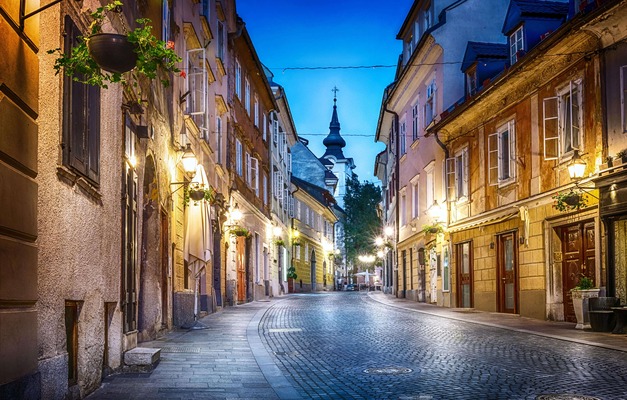
Croatia & Slovenia: 10 Days of Historic Coastline, Waterfalls & Mountains
 10 Day Tour of Dubrovnik, Split, Plitvice Lakes and Ljubljana
10 Day Tour of Dubrovnik, Split, Plitvice Lakes and Ljubljana
Overview
Trip Map
Itinerary
Inclusions
Reviews







10 Days 9 Nights
Best Time: Jan-Dec
Nature Lovers
History Buffs
Take a magical journey through the picturesque landscapes of Croatia and Slovenia. From the enchanting coastline of Dubrovnik to the serene beauty of Plitvice Lakes and historic allure of Ljubljana, this tour promises an array of breathtaking experiences. Explore majestic castles, wander ancient cities, and immerse yourself in natural wonders. Private guided tours provide deep dives into the culture and history of each location. With Go Real Travel, detailed guidance is always at your fingertips through our mobile app. Join us for a trip that combines the best of nature, history, and the mesmerizing coastline of two stunning countries.
- Soar above Dubrovnik by cable car for spectacular views of the old city.
- Stroll the medieval walls that protected Dubrovnik for centuries and gaze out at the sea.
- Marvel at the turquoise waters and waterfalls of Plitvice Lakes National Park.
- Discover the secrets of Predjama Castle, built directly into a cave.
- Take a boat to the picturesque Bled Island, a jewel in the heart of Slovenia’s mountains.
Take a magical journey through the picturesque landscapes of Croatia and Slovenia. From the enchanting coastline of Dubrovnik to the serene beauty of Plitvice Lakes and historic allure of Ljubljana, this tour promises an array of breathtaking experiences. Explore majestic castles, wander ancient cities, and immerse yourself in natural wonders. Private guided tours provide deep dives into the culture and history of each location. With Go Real Travel, detailed guidance is always at your fingertips through our mobile app. Join us for a trip that combines the best of nature, history, and the mesmerizing coastline of two stunning countries.
- Soar above Dubrovnik by cable car for spectacular views of the old city.
- Stroll the medieval walls that protected Dubrovnik for centuries and gaze out at the sea.
- Marvel at the turquoise waters and waterfalls of Plitvice Lakes National Park.
- Discover the secrets of Predjama Castle, built directly into a cave.
- Take a boat to the picturesque Bled Island, a jewel in the heart of Slovenia’s mountains.

Old City Walls
Historic Landmarks

Dubrovnik's Beaches
Natural Beauty

Mount Srd
Natural Beauty

Diocletian’s Palace
Castles & Chateaux

Bačvice Beach
Natural Beauty

Plitvice Lakes
Natural Beauty

The Upper Lakes
Natural Beauty

Triple Bridge
Architecture

Ljubljana Castle
Castles & Chateaux
Must see sights

Old City Walls
Historic Landmarks

Dubrovnik's Beaches
Natural Beauty

Mount Srd
Natural Beauty

Diocletian’s Palace
Castles & Chateaux

Bačvice Beach
Natural Beauty

Plitvice Lakes
Natural Beauty

The Upper Lakes
Natural Beauty

Triple Bridge
Architecture

Ljubljana Castle
Castles & Chateaux
Starting from
$2239
per person
 Not included
Not included Secure Your Customizable Trip
Enter your details to embark on a journey that can be tailored just for you.
Start
Travelers
Add Room
Remove Room
Preferred Hotel Stars
Craft Your Own Itinerary
Select your interests and destinations for a trip plan inspired by you.
Trip Map & Itinerary
Enable/Disable Map Scrolling
Click To Make Map Interactive

Trip Timeline
 Edit Details
Edit DetailsArrival
2 nights
Dubrovnik
Croatia
Ferry: 5h
2 nights
Split
Croatia
Shuttle: 2h45m
2 nights
Plitvice Lakes
Croatia
Shuttle: 3h15m
3 nights
Ljubljana
Slovenia
Departure
Day-By-Day Itinerary
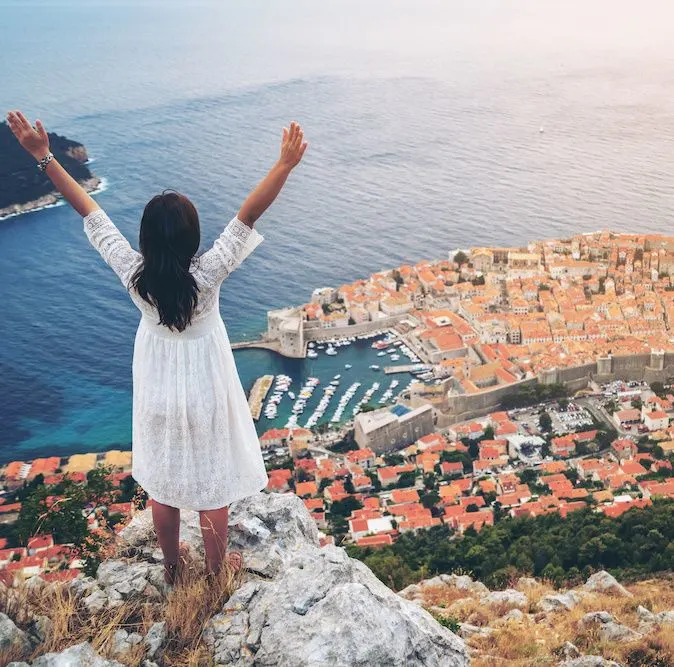
Day 1
Arrive Dubrovnik
View More
Day 1
Arrive Dubrovnik




To Be Determined
Arrival in Dubrovnik Airport and Transfer by Taxi or Bus
Dubrovnik has one main airport, Dubrovnik Airport, also referred to as Čilipi Airport. Taxis are available directly at the terminal exit, or you can arrange a private transfer for added convenience. The total cost of the trip should be approximately 45 EUR / 50 USD. There is a large yellow sign indicating taxi rates right beside the taxi stand. UberX or a local bus service is also available in Dubrovnik.

Day 1
Arrive Dubrovnik
View More


Day 1
Arrive Dubrovnik





To Be Determined:
Transfer from Airport
Mid-Day/Afternoon:
Mount Srd
Afternoon/Late Afternoon:
Old City Walls
Late Afternoon to Evening:
Beach Time

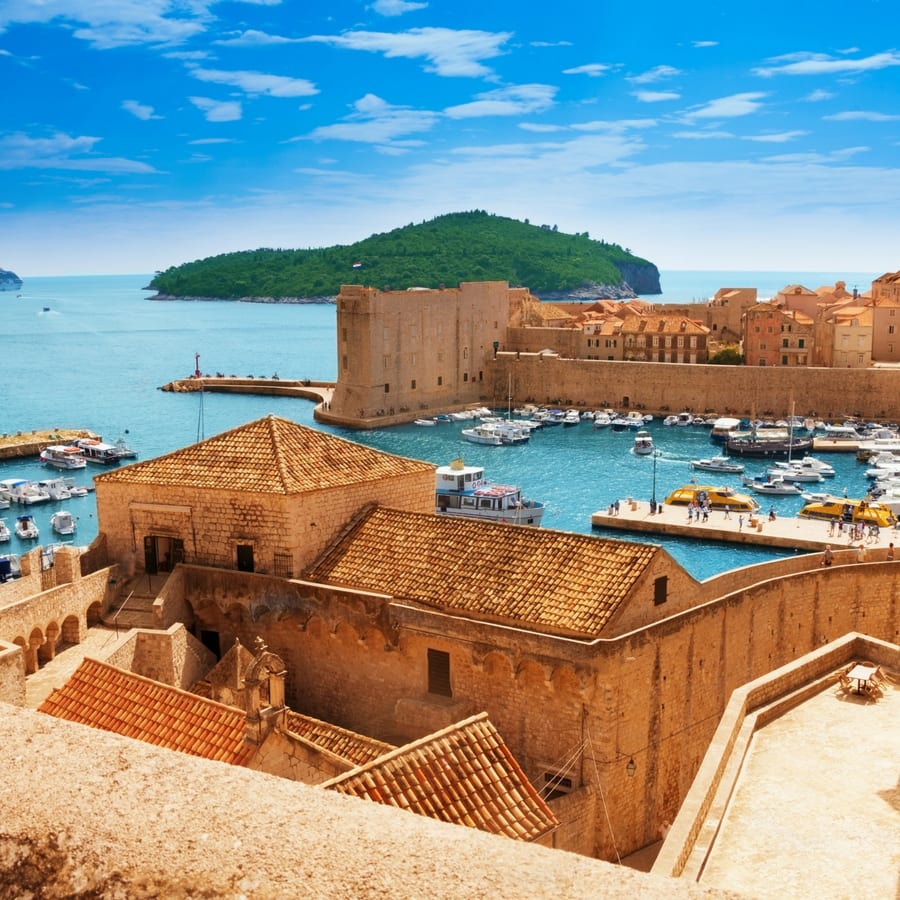
Day 2
Dubrovnik
View More
Day 2
Dubrovnik



9:00 AM - 11:00 AM
Guided Walking Tour of Dubrovnik's Old Town
Dubrovnik was able to accumulate vast fortunes as a safe trade route into the Balkan hinterland and thus create a remarkably beautiful city and gargantuan fortifications that remain astonishingly well preserved to today. On this two-hour private guided walking tour, you will experience the supreme delight of viewing the old town almost as it was centuries ago and learning about the history and culture of the city through the ages.

Orlando's Column
Monument
Show More

Rector's Palace
14th-century Gothic-Renaissance palace
Show More

Orlando's Column
Monument
Show More

Rector's Palace
14th-century Gothic-Renaissance palace
Show More

Orlando's Column
Monument
Show More

Rector's Palace
14th-century Gothic-Renaissance palace
Show More
prev
next

Day 2
Dubrovnik
View More

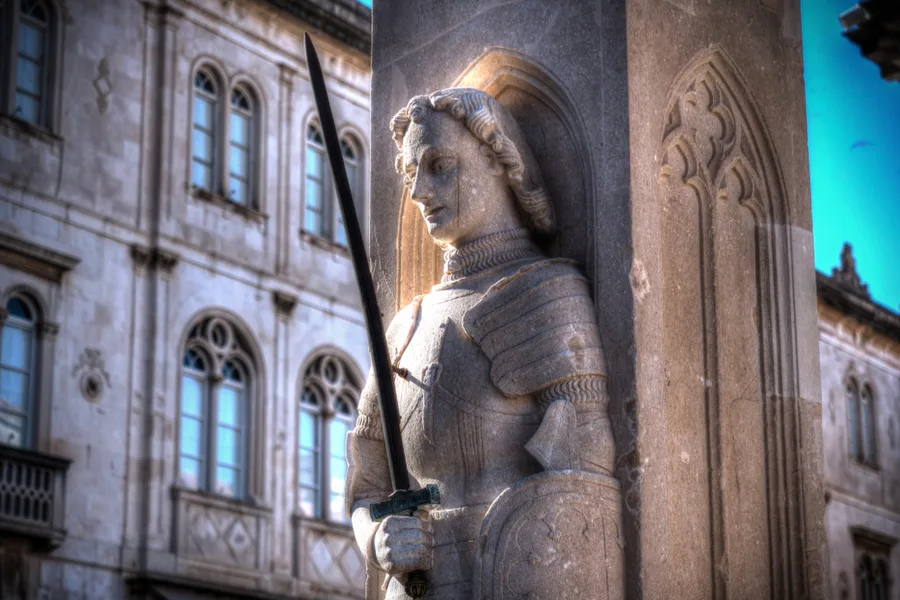
Orlando's Column
 Highlight of Guided Walking Tour of Dubrovnik's Old Town
Highlight of Guided Walking Tour of Dubrovnik's Old TownMonument
A monument in the heart of Old Town Dubrovnik. The column, erected in 1418, features the armored knight Orlando who according to the legend, helped the people of old Dubrovnik defeat invaders in the middle ages, therefore, helping Dubrovnik remain a free trade city-state.
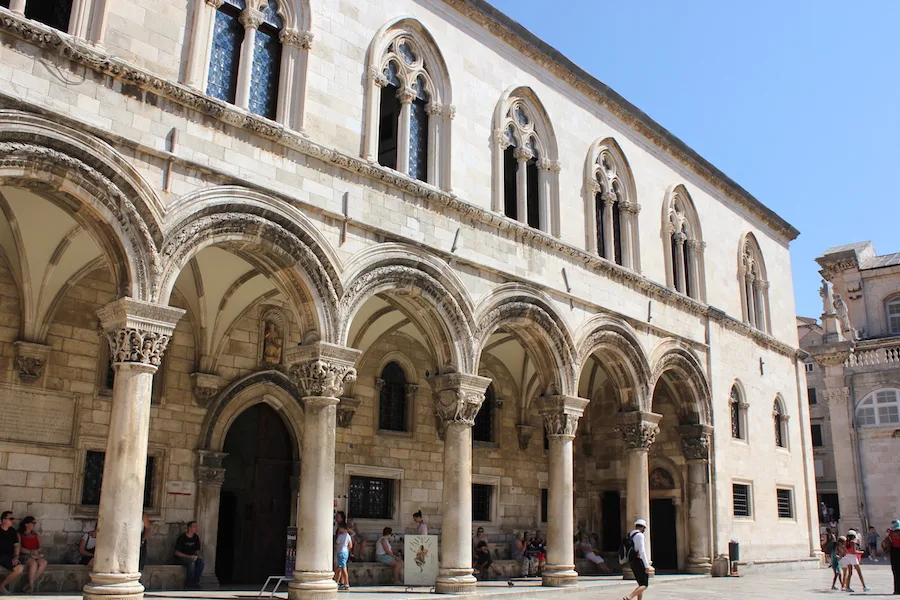
Rector's Palace
 Highlight of Guided Walking Tour of Dubrovnik's Old Town
Highlight of Guided Walking Tour of Dubrovnik's Old Town14th-century Gothic-Renaissance palace
14th-century Gothic-Renaissance palace featuring a museum

Orlando's Column
 Highlight of Guided Walking Tour of Dubrovnik's Old Town
Highlight of Guided Walking Tour of Dubrovnik's Old TownMonument
A monument in the heart of Old Town Dubrovnik. The column, erected in 1418, features the armored knight Orlando who according to the legend, helped the people of old Dubrovnik defeat invaders in the middle ages, therefore, helping Dubrovnik remain a free trade city-state.

Rector's Palace
 Highlight of Guided Walking Tour of Dubrovnik's Old Town
Highlight of Guided Walking Tour of Dubrovnik's Old Town14th-century Gothic-Renaissance palace
14th-century Gothic-Renaissance palace featuring a museum

Orlando's Column
 Highlight of Guided Walking Tour of Dubrovnik's Old Town
Highlight of Guided Walking Tour of Dubrovnik's Old TownMonument
A monument in the heart of Old Town Dubrovnik. The column, erected in 1418, features the armored knight Orlando who according to the legend, helped the people of old Dubrovnik defeat invaders in the middle ages, therefore, helping Dubrovnik remain a free trade city-state.

Rector's Palace
 Highlight of Guided Walking Tour of Dubrovnik's Old Town
Highlight of Guided Walking Tour of Dubrovnik's Old Town14th-century Gothic-Renaissance palace
14th-century Gothic-Renaissance palace featuring a museum
prev
next

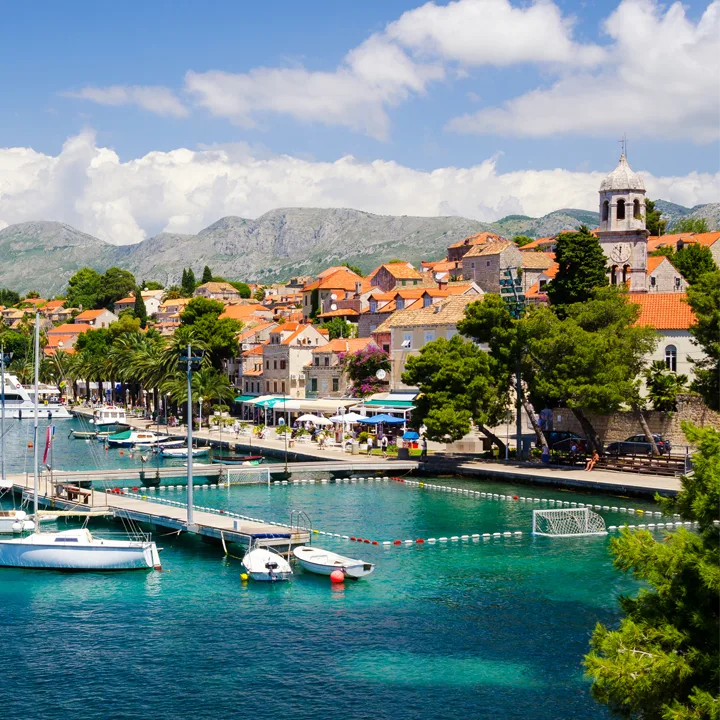
Day 3
Dubrovnik to Split
View More
Day 3
Dubrovnik to Split




Morning/Mid-Day
Excursion to the Old Resort Town of Cavtat
Less than 45 minutes by boat or bus from central Dubrovnik, Cavtat is a fascinating and cultured destination in itself. It perches on the saddle of a wooded peninsula set between two bays, so the water is never far away, and a wide promenade, fringed with palm trees, runs along the harbor front. It's an ideal half-day excursion from Dubrovnik where you can while away the hours exploring the town or soak up the sun on a rare sandy beach nearby. Much of Cavtat's allure survives is in the old part of the town, which straddles the ridge behind the waterfront. Badly damaged in what the Croats call the 'Homeland War' of the early 1990s, the town has been conveniently restored to its previous charm. The cosmopolitan center of the town, where fishing and tourist boats jostle with gleaming jet-set yachts the size of mini cruise liners, is crisscrossed with cobbled streets lined with traditional red-roofed brownstone houses that climb back from the gleaming turquoise-blue of the waterfront. The narrow stairways between the opposite sides of each street are carpeted in clouds of white, mauve and pink blossoms in spring and summer.

Monastery of Our Lady of the Snow
Check out this seaside monastery filled with several Renaissance art treasures.
Show More

Račić Mausoleum
Take a relaxing walk up the hill to this interesting mausoleum in a cemetery overlooking the town.
Show More

Monastery of Our Lady of the Snow
Check out this seaside monastery filled with several Renaissance art treasures.
Show More

Račić Mausoleum
Take a relaxing walk up the hill to this interesting mausoleum in a cemetery overlooking the town.
Show More

Monastery of Our Lady of the Snow
Check out this seaside monastery filled with several Renaissance art treasures.
Show More

Račić Mausoleum
Take a relaxing walk up the hill to this interesting mausoleum in a cemetery overlooking the town.
Show More
prev
next

Day 3
Dubrovnik to Split
View More

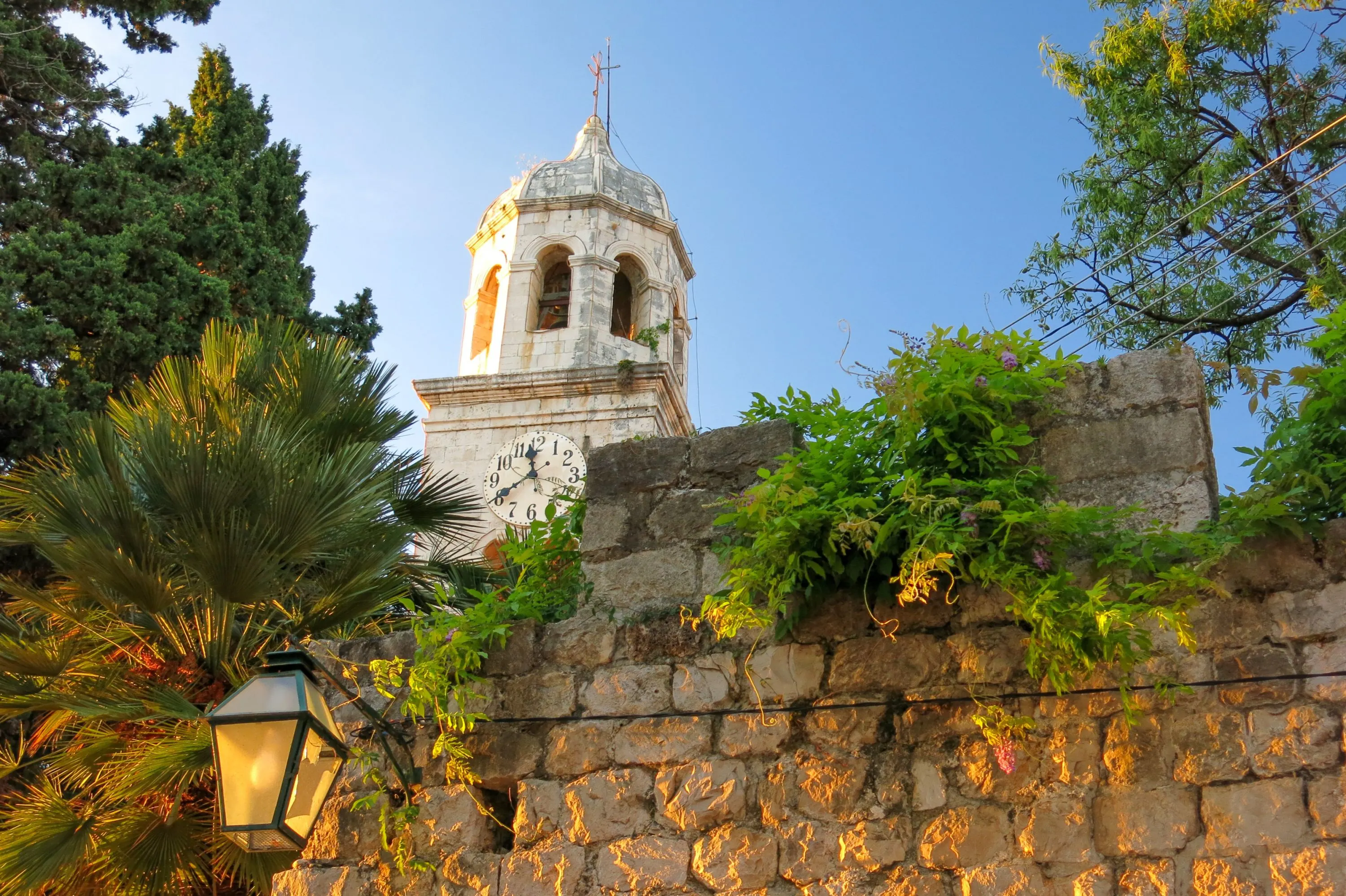
Monastery of Our Lady of the Snow
 Highlight of Cavtat
Highlight of CavtatCheck out this seaside monastery filled with several Renaissance art treasures.
The Monastery of Our Lady of the Snow contains some early Renaissance gems in its small church. There's also a wonderful Bukovac work above the entrance to the sanctuary, depicting the Madonna and Child gazing at the Cavtat skyline at sunset. If you don't know the legend, then it relates to a Roman patrician couple in the 14th century, who were without heirs, and who made a vow to donate their possessions to the Virgin Mary. They prayed that she might make known to them how they were to dispose of their property in her honor. On 5 August, at the height of the Roman summer, snow fell during the night on the summit of the Esquiline Hill. The locals in Cavtat relate the story to an attack on the town by Venetians or pirates, and in response to their prayers to St Mary it began to snow despite the fact that it was also the middle of summer; the enemy fleet took fright at the sign of such a miracle and weighed anchor.

Račić Mausoleum
 Highlight of Cavtat
Highlight of CavtatTake a relaxing walk up the hill to this interesting mausoleum in a cemetery overlooking the town.
This octagonal white dome with huge bronze doors decorated with gargoyles of dogs, eagles and winged lambs, was built high above Cavtat in the early 1920s by the ubiquitous Croatian sculptor Ivan Meštrović for a wealthy local ship-owning family. Even if you prefer not to visit this marble folly, the walk to it is definitely worthwhile. At the hub of its quayside activity, Cavtat feels full of light and air but still a bit busy. But venture back from the harbourfront, following the signs for the mausoleum, and you discover another world altogether - a spacious rural idyll.

Monastery of Our Lady of the Snow
 Highlight of Cavtat
Highlight of CavtatCheck out this seaside monastery filled with several Renaissance art treasures.
The Monastery of Our Lady of the Snow contains some early Renaissance gems in its small church. There's also a wonderful Bukovac work above the entrance to the sanctuary, depicting the Madonna and Child gazing at the Cavtat skyline at sunset. If you don't know the legend, then it relates to a Roman patrician couple in the 14th century, who were without heirs, and who made a vow to donate their possessions to the Virgin Mary. They prayed that she might make known to them how they were to dispose of their property in her honor. On 5 August, at the height of the Roman summer, snow fell during the night on the summit of the Esquiline Hill. The locals in Cavtat relate the story to an attack on the town by Venetians or pirates, and in response to their prayers to St Mary it began to snow despite the fact that it was also the middle of summer; the enemy fleet took fright at the sign of such a miracle and weighed anchor.

Račić Mausoleum
 Highlight of Cavtat
Highlight of CavtatTake a relaxing walk up the hill to this interesting mausoleum in a cemetery overlooking the town.
This octagonal white dome with huge bronze doors decorated with gargoyles of dogs, eagles and winged lambs, was built high above Cavtat in the early 1920s by the ubiquitous Croatian sculptor Ivan Meštrović for a wealthy local ship-owning family. Even if you prefer not to visit this marble folly, the walk to it is definitely worthwhile. At the hub of its quayside activity, Cavtat feels full of light and air but still a bit busy. But venture back from the harbourfront, following the signs for the mausoleum, and you discover another world altogether - a spacious rural idyll.

Monastery of Our Lady of the Snow
 Highlight of Cavtat
Highlight of CavtatCheck out this seaside monastery filled with several Renaissance art treasures.
The Monastery of Our Lady of the Snow contains some early Renaissance gems in its small church. There's also a wonderful Bukovac work above the entrance to the sanctuary, depicting the Madonna and Child gazing at the Cavtat skyline at sunset. If you don't know the legend, then it relates to a Roman patrician couple in the 14th century, who were without heirs, and who made a vow to donate their possessions to the Virgin Mary. They prayed that she might make known to them how they were to dispose of their property in her honor. On 5 August, at the height of the Roman summer, snow fell during the night on the summit of the Esquiline Hill. The locals in Cavtat relate the story to an attack on the town by Venetians or pirates, and in response to their prayers to St Mary it began to snow despite the fact that it was also the middle of summer; the enemy fleet took fright at the sign of such a miracle and weighed anchor.

Račić Mausoleum
 Highlight of Cavtat
Highlight of CavtatTake a relaxing walk up the hill to this interesting mausoleum in a cemetery overlooking the town.
This octagonal white dome with huge bronze doors decorated with gargoyles of dogs, eagles and winged lambs, was built high above Cavtat in the early 1920s by the ubiquitous Croatian sculptor Ivan Meštrović for a wealthy local ship-owning family. Even if you prefer not to visit this marble folly, the walk to it is definitely worthwhile. At the hub of its quayside activity, Cavtat feels full of light and air but still a bit busy. But venture back from the harbourfront, following the signs for the mausoleum, and you discover another world altogether - a spacious rural idyll.
prev
next

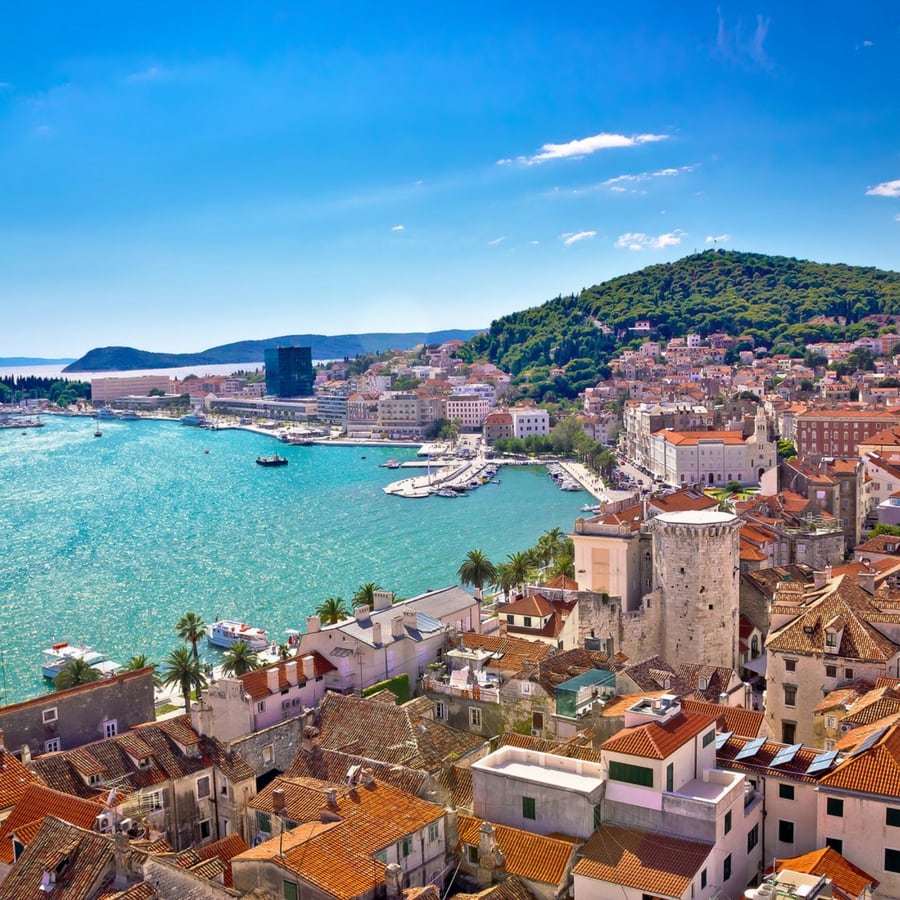
Day 4
Split
View More
Day 4
Split



9:00 AM - 11:00 AM
Walking Tour of Split Old Town & Diocletian's Palace
This two-hour guided tour will take you to the Roman emperor Diocletian's 1700-year-old palace which was built as his personal rest home. Walk from the Bronze Gate through the central hall of the ancient cellars is the main communication line between the busy waterfront promenade, the Riva, and the palace's main forecourt, the Peristyle. You'll also stop by the Cathedral of St Duje, one of the most beautiful cultural attractions on the Adriatic coast, the Roman temple of Jupiter (latterly a Christian baptistry), the fabulous Golden Gate, and the medieval Croatian bishop who introduced the Croatian language in religious services.

Peristyle
See the beautiful courtyard which was once the center of the palace, and is now the heart of Split.
Show More

Bronze Gate and Palace Cellars
Enter this ancient gateway to discover palace cellars used as film sets for Game of Thrones.
Show More

Peristyle
See the beautiful courtyard which was once the center of the palace, and is now the heart of Split.
Show More

Bronze Gate and Palace Cellars
Enter this ancient gateway to discover palace cellars used as film sets for Game of Thrones.
Show More

Peristyle
See the beautiful courtyard which was once the center of the palace, and is now the heart of Split.
Show More

Bronze Gate and Palace Cellars
Enter this ancient gateway to discover palace cellars used as film sets for Game of Thrones.
Show More
prev
next

Day 4
Split
View More

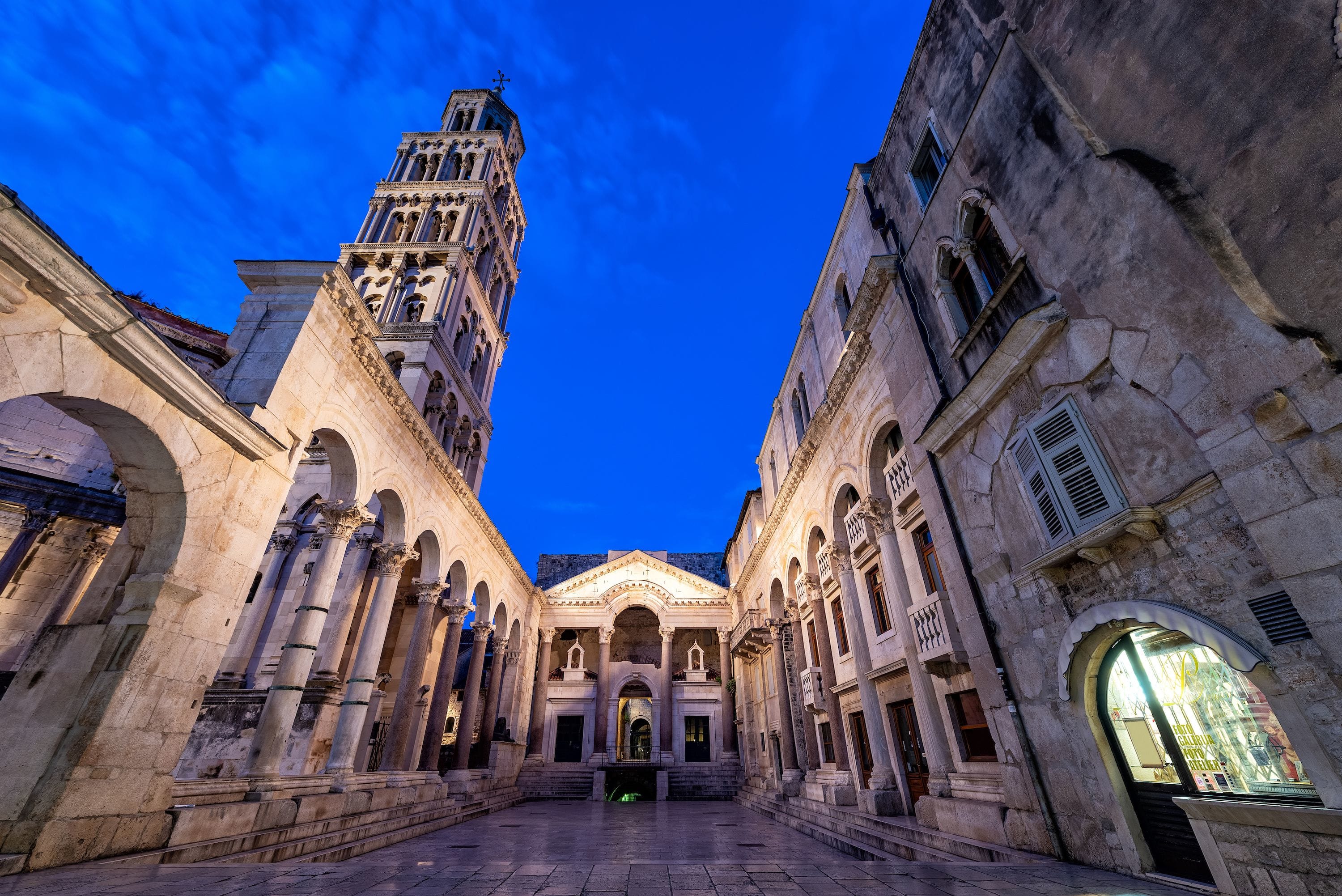
Peristyle
 Highlight of Split Old Town Walking Tour
Highlight of Split Old Town Walking TourSee the beautiful courtyard which was once the center of the palace, and is now the heart of Split.
The Peristyle was the central courtyard of the palace complex and the crossing point of its main streets. The columns around the courtyard were pillaged from Egypt, though the officer in charge of the operation must have forgotten to get some extras as four of the columns are clearly different from the others. There's also a black granite Egyptian sphinx on one side dating from 1500 BC which originally flanked the entrance to Diocletian's mausoleum (other sphinxes around the palace were decapitated by Diocletian to allay his superstition that they posed a threat to his rule). If you sit on one of the red cushions scattered around the Peristyle you'll be approached by a waiter with a menu of very expensive drinks, but it may be worth it just to sit and lap up the history and watch people go by. At the southern end of the Peristyle, steps lead up to a cone-shaped, roofless chamber which once served as the palace vestibule. Visitors would wait here before being summoned before the ex-emperor into his private apartments.
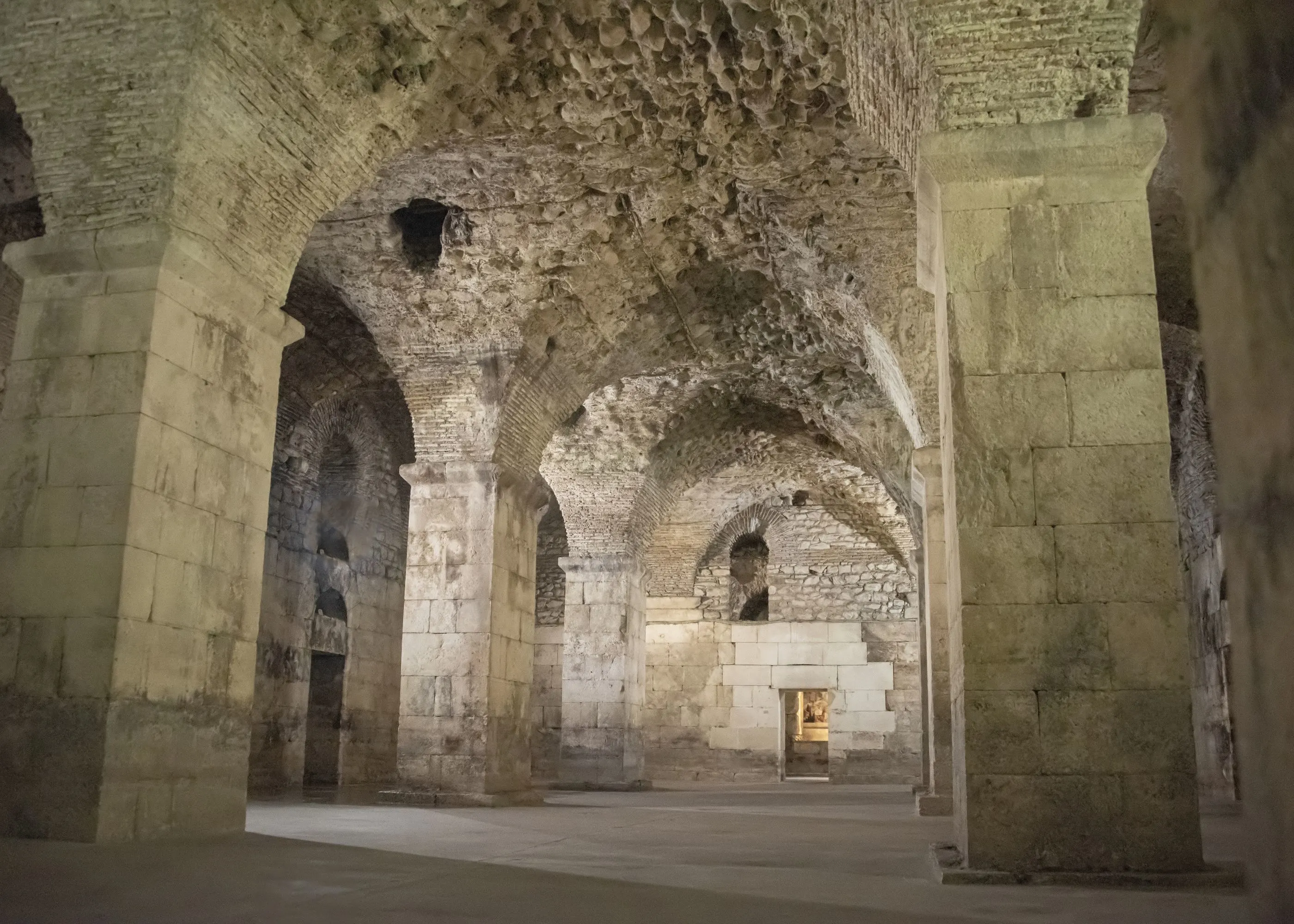
Bronze Gate and Palace Cellars
 Highlight of Split Old Town Walking Tour
Highlight of Split Old Town Walking TourEnter this ancient gateway to discover palace cellars used as film sets for Game of Thrones.
While today about 200 feet (60m) from the water, the Bronze Gate originally sat directly on the sea, allowing boats to pull directly up to the palace. As you enter the gate you will find a mass of souvenir and arts & crafts stalls, but just inside the entrance on either side are the substructures, or cellars of the palace. After the palace fell into disrepair, the cellars were used as rubbish pits. Families occupying the apartments above would simply create holes in the floor and voila, they had an instant trash dump with a seemingly unending supply of space. Of course centuries of trash did eventually them fill up and they were only rediscovered in 1956; the excavations continue to this very day. While entrance to the cellar is not free, it provides an excellent idea of what the palace must originally have looked like, as they're an exact mirror image of the imperial living quarters above. Game of Thrones fans will also be happy to learn that the cellar was used as a filming set, including as Daenerys Targaryen's grand Meereen throne room.

Peristyle
 Highlight of Split Old Town Walking Tour
Highlight of Split Old Town Walking TourSee the beautiful courtyard which was once the center of the palace, and is now the heart of Split.
The Peristyle was the central courtyard of the palace complex and the crossing point of its main streets. The columns around the courtyard were pillaged from Egypt, though the officer in charge of the operation must have forgotten to get some extras as four of the columns are clearly different from the others. There's also a black granite Egyptian sphinx on one side dating from 1500 BC which originally flanked the entrance to Diocletian's mausoleum (other sphinxes around the palace were decapitated by Diocletian to allay his superstition that they posed a threat to his rule). If you sit on one of the red cushions scattered around the Peristyle you'll be approached by a waiter with a menu of very expensive drinks, but it may be worth it just to sit and lap up the history and watch people go by. At the southern end of the Peristyle, steps lead up to a cone-shaped, roofless chamber which once served as the palace vestibule. Visitors would wait here before being summoned before the ex-emperor into his private apartments.

Bronze Gate and Palace Cellars
 Highlight of Split Old Town Walking Tour
Highlight of Split Old Town Walking TourEnter this ancient gateway to discover palace cellars used as film sets for Game of Thrones.
While today about 200 feet (60m) from the water, the Bronze Gate originally sat directly on the sea, allowing boats to pull directly up to the palace. As you enter the gate you will find a mass of souvenir and arts & crafts stalls, but just inside the entrance on either side are the substructures, or cellars of the palace. After the palace fell into disrepair, the cellars were used as rubbish pits. Families occupying the apartments above would simply create holes in the floor and voila, they had an instant trash dump with a seemingly unending supply of space. Of course centuries of trash did eventually them fill up and they were only rediscovered in 1956; the excavations continue to this very day. While entrance to the cellar is not free, it provides an excellent idea of what the palace must originally have looked like, as they're an exact mirror image of the imperial living quarters above. Game of Thrones fans will also be happy to learn that the cellar was used as a filming set, including as Daenerys Targaryen's grand Meereen throne room.

Peristyle
 Highlight of Split Old Town Walking Tour
Highlight of Split Old Town Walking TourSee the beautiful courtyard which was once the center of the palace, and is now the heart of Split.
The Peristyle was the central courtyard of the palace complex and the crossing point of its main streets. The columns around the courtyard were pillaged from Egypt, though the officer in charge of the operation must have forgotten to get some extras as four of the columns are clearly different from the others. There's also a black granite Egyptian sphinx on one side dating from 1500 BC which originally flanked the entrance to Diocletian's mausoleum (other sphinxes around the palace were decapitated by Diocletian to allay his superstition that they posed a threat to his rule). If you sit on one of the red cushions scattered around the Peristyle you'll be approached by a waiter with a menu of very expensive drinks, but it may be worth it just to sit and lap up the history and watch people go by. At the southern end of the Peristyle, steps lead up to a cone-shaped, roofless chamber which once served as the palace vestibule. Visitors would wait here before being summoned before the ex-emperor into his private apartments.

Bronze Gate and Palace Cellars
 Highlight of Split Old Town Walking Tour
Highlight of Split Old Town Walking TourEnter this ancient gateway to discover palace cellars used as film sets for Game of Thrones.
While today about 200 feet (60m) from the water, the Bronze Gate originally sat directly on the sea, allowing boats to pull directly up to the palace. As you enter the gate you will find a mass of souvenir and arts & crafts stalls, but just inside the entrance on either side are the substructures, or cellars of the palace. After the palace fell into disrepair, the cellars were used as rubbish pits. Families occupying the apartments above would simply create holes in the floor and voila, they had an instant trash dump with a seemingly unending supply of space. Of course centuries of trash did eventually them fill up and they were only rediscovered in 1956; the excavations continue to this very day. While entrance to the cellar is not free, it provides an excellent idea of what the palace must originally have looked like, as they're an exact mirror image of the imperial living quarters above. Game of Thrones fans will also be happy to learn that the cellar was used as a filming set, including as Daenerys Targaryen's grand Meereen throne room.
prev
next

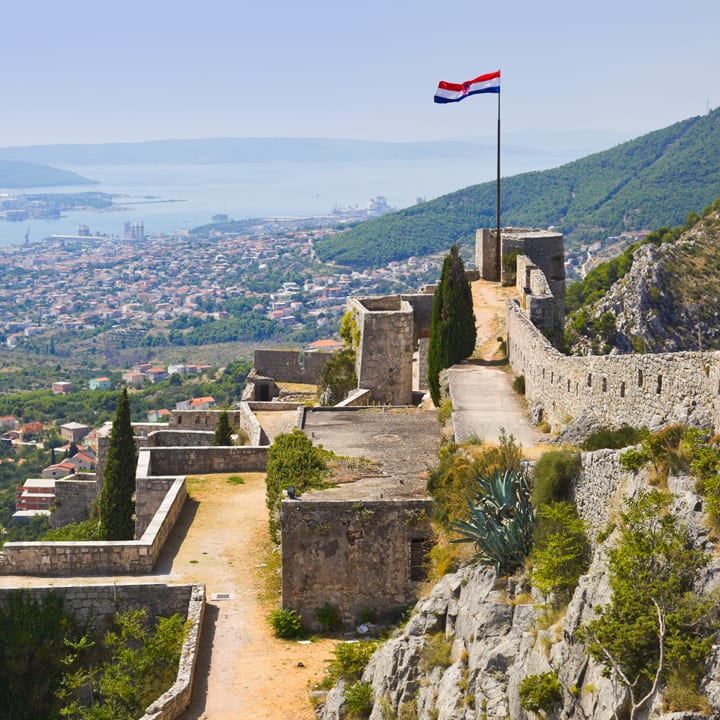
Day 5
Split to Plitvice Lakes
View More
Day 5
Split to Plitvice Lakes


Morning
Excursion to Klis Fortress
For thousands of years the mighty and imposing Klis Fortress, with its grand views of the Dalmatian Coast, has been guarding the strategic mountain pass just above Split. For many modern visitors, however, more significant than the real history of the castle is its use as a film set for the city-state of Meereen in Game of Thrones. In either case, ciimbing the fortress's steep trails and exploring its ruins makes for a fascinating visit. The remarkably intact structure with grand views of the Dalmatian Coast was first fortified by the ancient Illyrian tribe of the Dalmatae, and later by Romans. In medieval times it was a seat of power for the expanding medieval kingdom of the Croats, even repelling a Mongol army in 1242. Klis was later defended by a band of irregular Croatian defenders, the Uskoks, who managed to hold off repeated sieges by the Ottoman Turks until finally being defeated in 1537. Within the fortress you'll find an interesting exhibit on the Uskoks. Retaken from the Turks in 1648, the fortress changed hands several more times, and saw its last military action during the Second World War when it was a stronghold for Italian and German occupation forces. These days, you can easily conquer the fortifications yourself via the local bus line 22 from Split. Even more easy is the Promet tourist bus which leaves from the main bus station and reaches the fortress in 20 minutes. Of course most convenient is take a guided tour which can explain both the real and the cinematic story behind the fortress.

Day 5
Split to Plitvice Lakes
View More


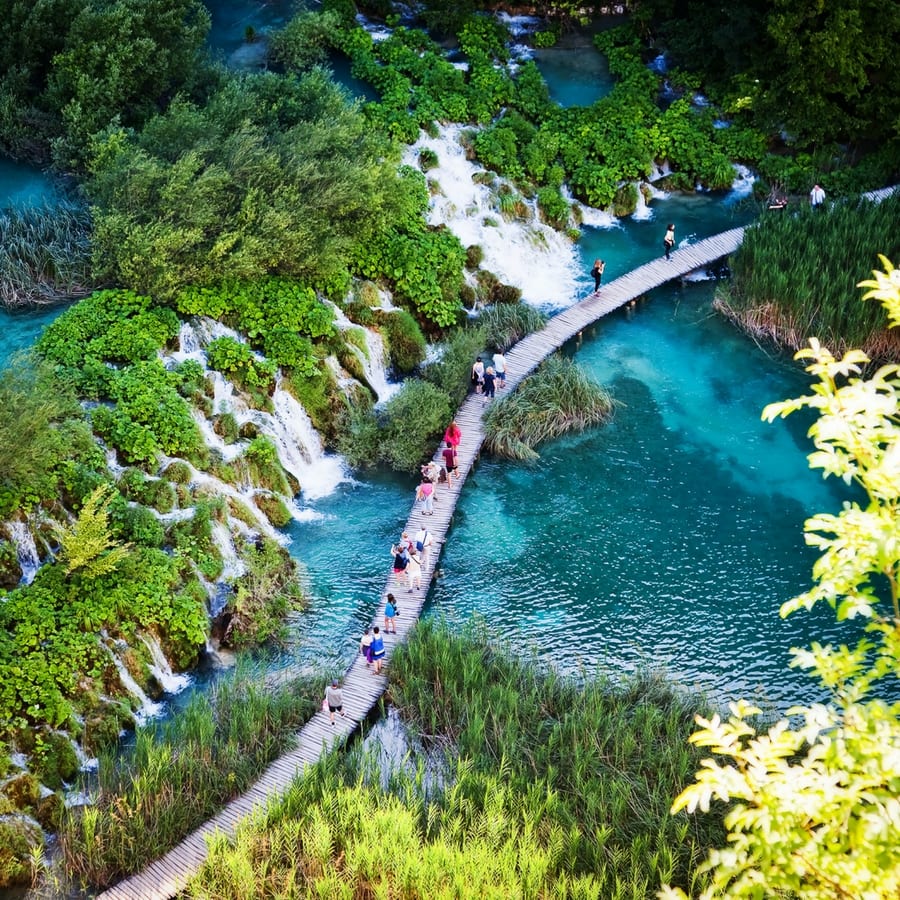
Day 6
Plitvice Lakes
View More
Day 6
Plitvice Lakes


8:00 AM - 12:00 PM
Guided Tour of Plitvice Lakes
On this private four-hour tour you will see the most eye-catching and majestic of any natural attraction in Croatia, if not all the Balkans; the Plitvice Lakes National Park is an astounding 8-kilometer (5-mile) stretch of 16 lakes that cascade one into the other over a terraced sequence of barriers formed over millennia. Thanks to its mineral-rich waters, the Park's lakes practically glow with a brilliant turquoise hue when seen from afar, and are crystal clear up close.

Day 6
Plitvice Lakes
View More



Day 7
Plitvice Lakes to Ljubljana
View More
Day 7
Plitvice Lakes to Ljubljana



8:00 AM - 11:15 AM
Private Transfer to Ljubljana
A private transfer with door-to-door service is certainly the most convenient way to travel. While bus connections do exist for this route, and are usually more affordable and carbon-friendly, you may prefer the ease of travel and service offered by a private driver. Taking the bus will require at least 3 extra hours of travel time as well as a connection in Zagreb, meaning you have to purchase two separate tickets with no guarantees in case of delays from the first leg. The 3-4 hour journey to Ljubljana takes you through the picturesque landscape of Slovenia and Croatia. Much of the journey will be along often winding 2-lane highways, but for at least part of the journey, you will take advantage of the excellent 4-lane highway systems in Slovenia.

Day 7
Plitvice Lakes to Ljubljana
View More


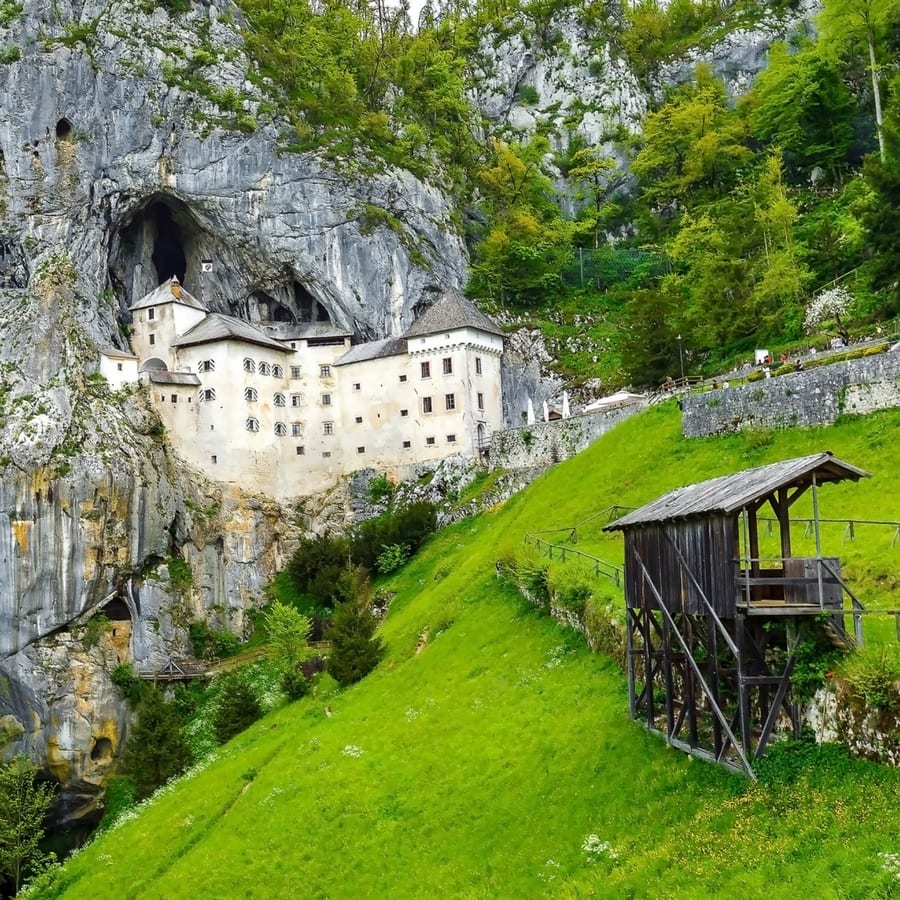
Day 8
Ljubljana
View More
Day 8
Ljubljana

Morning to Evening
Excursion to Postojna Caves & Predjama Castle
Two of Slovenia's most famous and impressive attractions are located about 6 miles (10km) from each other, meaning that it's a no-brainer to see both of them on the same excursion. The other-worldly Postojna Caves are some of Europe's most impressive, while the wonderfully dramatic Predjama Castle, 9km north of the cave, is built into a setting as unforgettable as it is improbable.

Postojna Cave
Take a train deep inside a mountain to explore these wondrously beautiful caverns.
Show More

Postojna Cave
Take a train deep inside a mountain to explore these wondrously beautiful caverns.
Show More

Postojna Cave
Take a train deep inside a mountain to explore these wondrously beautiful caverns.
Show More

Postojna Cave
Take a train deep inside a mountain to explore these wondrously beautiful caverns.
Show More

Postojna Cave
Take a train deep inside a mountain to explore these wondrously beautiful caverns.
Show More
prev
next

Day 8
Ljubljana
View More

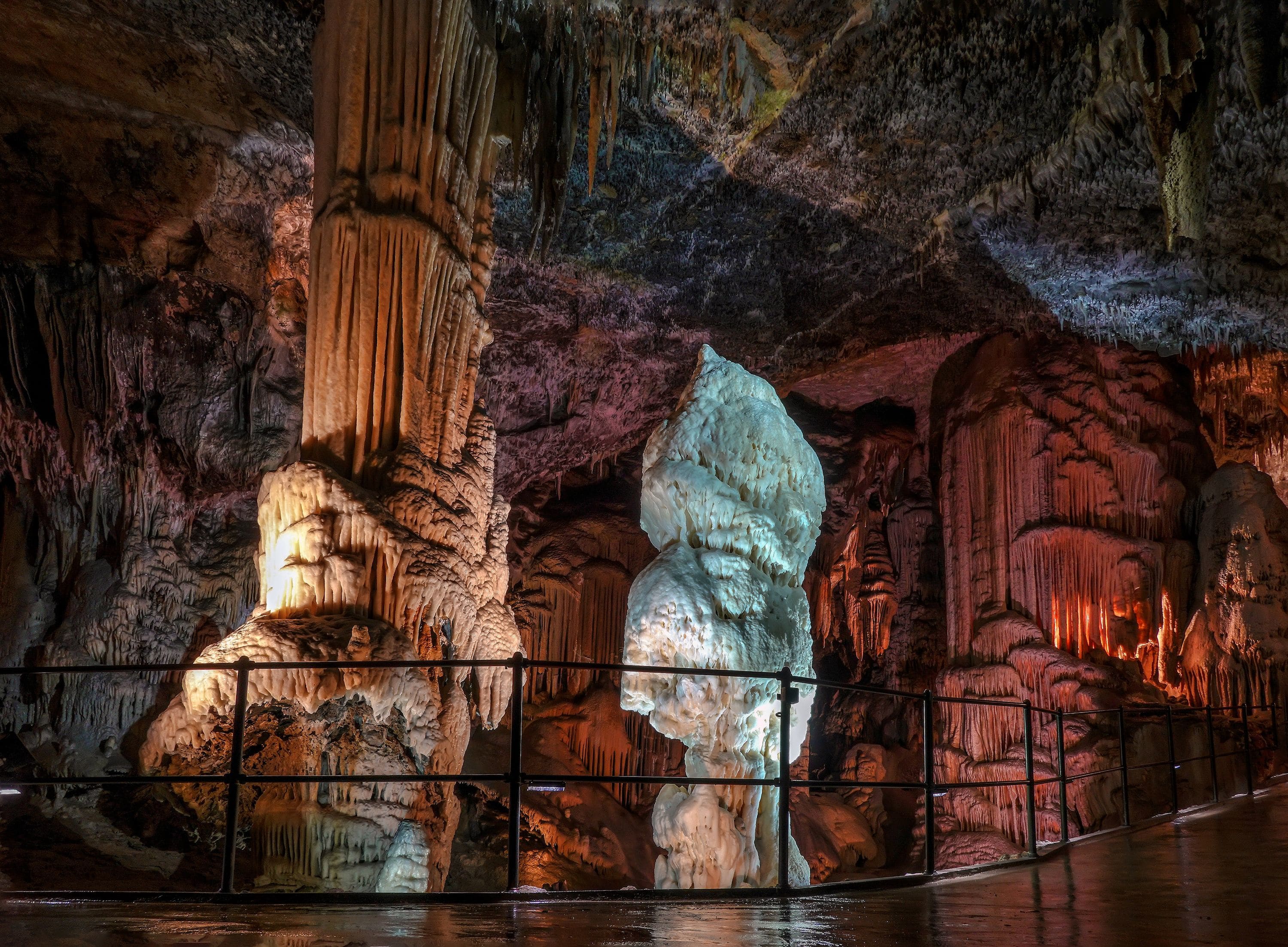
Postojna Cave
 Highlight of Postojna Caves & Predjama Castle
Highlight of Postojna Caves & Predjama CastleTake a train deep inside a mountain to explore these wondrously beautiful caverns.
Postojna's wondrously vast complex of naturally formed underground chambers and an astonishing array of stalactite and stalagmite formations has been attracting open-mouthed visitors for two centuries already, thanks in no small way to the open-topped electric train that shuttles punters 1.2 mile (2km) inside the cave system before the guided tours begin. As fascinating and multifarious as they are, the tour isn't all stalactites and stalagmites and how they've formed over the millennia. You also get a commentary on the alterations humans have made to the cave over the 200 years since it's discovery and you'll be shown how incipient stalactites have even started to form on concrete arches built over 90 years ago. Near the end of the tour, you will be introduced to the cave's 'baby dragons', or which people once believed were dragons - olms or 'Proteus anguinus'. With a length of 25 to 30 centimeters, the olm is the largest cave-dwelling animal and the only vertebrate in Europe that lives exclusively in subterranean areas. It is extremely well-adapted to life in darkness; its skin lacks any protective pigmentation, and the blood that shows through it makes it very pale and slightly pink in colour. The resemblance in colour to that of white-skinned humans is the reason why the olm is in some languages referred to as the human fish. It has a life expectancy of up to 100 years and can survive without food for several years.

Postojna Cave
 Highlight of Postojna Caves & Predjama Castle
Highlight of Postojna Caves & Predjama CastleTake a train deep inside a mountain to explore these wondrously beautiful caverns.
Postojna's wondrously vast complex of naturally formed underground chambers and an astonishing array of stalactite and stalagmite formations has been attracting open-mouthed visitors for two centuries already, thanks in no small way to the open-topped electric train that shuttles punters 1.2 mile (2km) inside the cave system before the guided tours begin. As fascinating and multifarious as they are, the tour isn't all stalactites and stalagmites and how they've formed over the millennia. You also get a commentary on the alterations humans have made to the cave over the 200 years since it's discovery and you'll be shown how incipient stalactites have even started to form on concrete arches built over 90 years ago. Near the end of the tour, you will be introduced to the cave's 'baby dragons', or which people once believed were dragons - olms or 'Proteus anguinus'. With a length of 25 to 30 centimeters, the olm is the largest cave-dwelling animal and the only vertebrate in Europe that lives exclusively in subterranean areas. It is extremely well-adapted to life in darkness; its skin lacks any protective pigmentation, and the blood that shows through it makes it very pale and slightly pink in colour. The resemblance in colour to that of white-skinned humans is the reason why the olm is in some languages referred to as the human fish. It has a life expectancy of up to 100 years and can survive without food for several years.

Postojna Cave
 Highlight of Postojna Caves & Predjama Castle
Highlight of Postojna Caves & Predjama CastleTake a train deep inside a mountain to explore these wondrously beautiful caverns.
Postojna's wondrously vast complex of naturally formed underground chambers and an astonishing array of stalactite and stalagmite formations has been attracting open-mouthed visitors for two centuries already, thanks in no small way to the open-topped electric train that shuttles punters 1.2 mile (2km) inside the cave system before the guided tours begin. As fascinating and multifarious as they are, the tour isn't all stalactites and stalagmites and how they've formed over the millennia. You also get a commentary on the alterations humans have made to the cave over the 200 years since it's discovery and you'll be shown how incipient stalactites have even started to form on concrete arches built over 90 years ago. Near the end of the tour, you will be introduced to the cave's 'baby dragons', or which people once believed were dragons - olms or 'Proteus anguinus'. With a length of 25 to 30 centimeters, the olm is the largest cave-dwelling animal and the only vertebrate in Europe that lives exclusively in subterranean areas. It is extremely well-adapted to life in darkness; its skin lacks any protective pigmentation, and the blood that shows through it makes it very pale and slightly pink in colour. The resemblance in colour to that of white-skinned humans is the reason why the olm is in some languages referred to as the human fish. It has a life expectancy of up to 100 years and can survive without food for several years.

Postojna Cave
 Highlight of Postojna Caves & Predjama Castle
Highlight of Postojna Caves & Predjama CastleTake a train deep inside a mountain to explore these wondrously beautiful caverns.
Postojna's wondrously vast complex of naturally formed underground chambers and an astonishing array of stalactite and stalagmite formations has been attracting open-mouthed visitors for two centuries already, thanks in no small way to the open-topped electric train that shuttles punters 1.2 mile (2km) inside the cave system before the guided tours begin. As fascinating and multifarious as they are, the tour isn't all stalactites and stalagmites and how they've formed over the millennia. You also get a commentary on the alterations humans have made to the cave over the 200 years since it's discovery and you'll be shown how incipient stalactites have even started to form on concrete arches built over 90 years ago. Near the end of the tour, you will be introduced to the cave's 'baby dragons', or which people once believed were dragons - olms or 'Proteus anguinus'. With a length of 25 to 30 centimeters, the olm is the largest cave-dwelling animal and the only vertebrate in Europe that lives exclusively in subterranean areas. It is extremely well-adapted to life in darkness; its skin lacks any protective pigmentation, and the blood that shows through it makes it very pale and slightly pink in colour. The resemblance in colour to that of white-skinned humans is the reason why the olm is in some languages referred to as the human fish. It has a life expectancy of up to 100 years and can survive without food for several years.

Postojna Cave
 Highlight of Postojna Caves & Predjama Castle
Highlight of Postojna Caves & Predjama CastleTake a train deep inside a mountain to explore these wondrously beautiful caverns.
Postojna's wondrously vast complex of naturally formed underground chambers and an astonishing array of stalactite and stalagmite formations has been attracting open-mouthed visitors for two centuries already, thanks in no small way to the open-topped electric train that shuttles punters 1.2 mile (2km) inside the cave system before the guided tours begin. As fascinating and multifarious as they are, the tour isn't all stalactites and stalagmites and how they've formed over the millennia. You also get a commentary on the alterations humans have made to the cave over the 200 years since it's discovery and you'll be shown how incipient stalactites have even started to form on concrete arches built over 90 years ago. Near the end of the tour, you will be introduced to the cave's 'baby dragons', or which people once believed were dragons - olms or 'Proteus anguinus'. With a length of 25 to 30 centimeters, the olm is the largest cave-dwelling animal and the only vertebrate in Europe that lives exclusively in subterranean areas. It is extremely well-adapted to life in darkness; its skin lacks any protective pigmentation, and the blood that shows through it makes it very pale and slightly pink in colour. The resemblance in colour to that of white-skinned humans is the reason why the olm is in some languages referred to as the human fish. It has a life expectancy of up to 100 years and can survive without food for several years.
prev
next

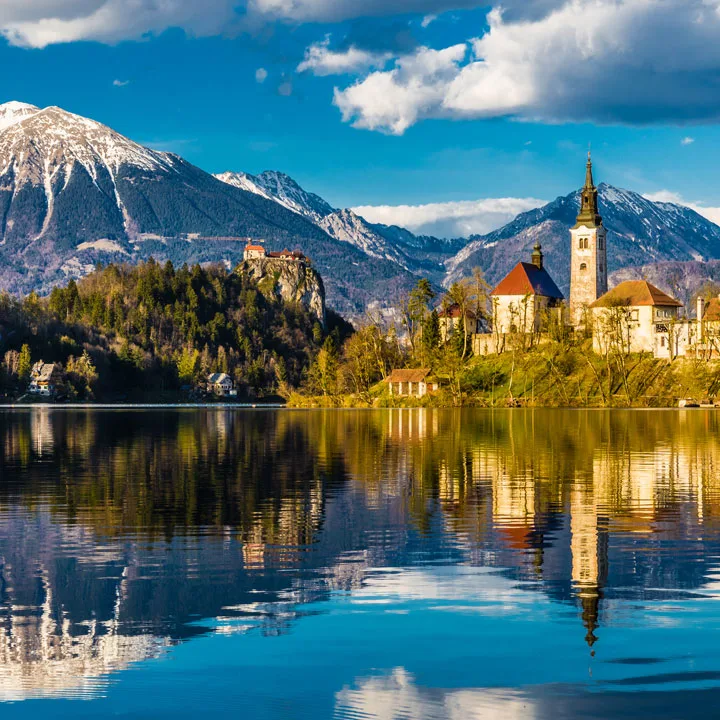
Day 9
Ljubljana
View More
Day 9
Ljubljana

Early Morning to Late Afternoon
Self Guided Excursion to the Picturesque Lake Bled
With its mountain setting, dark turquoise waters, boats rowing passengers out to the island church, and dramatic cliff-top castle, Lake Bled is picture-postcard perfect, making it the most popular destination in Slovenia for both international and domestic tourists alike. You can take a walk or ride a tourist train around the lake, row out to the island, and dine alongside the enchanting shoreline. With enough time to spare, you can also take in the dramatic Vintgar Gorge and the beautiful medieval village of Radovljica. Lake Bled is about an hour-and-a-half trip from Ljubljana. You have two options for getting to there by public transport - bus or train. Buses depart Ljubljana more frequently and arrive at a very convenient location near the lakeshore in Bled, but they can get very crowded during the summer, especially at the weekends when seemingly every young backpacker in the country wants to get there, while the train departs more infrequently and doesn't arrive directly in Bled, but it isn't as crowded. Of course you can also just take a guided excursion if you want to keep it simple.

Vintgar Gorge
Follow along the cliffsides deep into this incredibly scenic gorge.
Show More

The Village of Radovljica and its Beekeeping Museum
If you like honey, chocolate, and gingerbread, make time for the small but exquisitely preserved medieval town of Radovljica, just 4 miles (6km) south-east of Bled.
Show More

Bled Island
Row (or be rowed) to this beautiful island in the center of Lake Bled.
Show More

Bled Castle
Stare down at the lake from this dramatic castle precariously perched on a cliff.
Show More

Vintgar Gorge
Follow along the cliffsides deep into this incredibly scenic gorge.
Show More

The Village of Radovljica and its Beekeeping Museum
If you like honey, chocolate, and gingerbread, make time for the small but exquisitely preserved medieval town of Radovljica, just 4 miles (6km) south-east of Bled.
Show More

Bled Island
Row (or be rowed) to this beautiful island in the center of Lake Bled.
Show More

Bled Castle
Stare down at the lake from this dramatic castle precariously perched on a cliff.
Show More
prev
next

Day 9
Ljubljana
View More

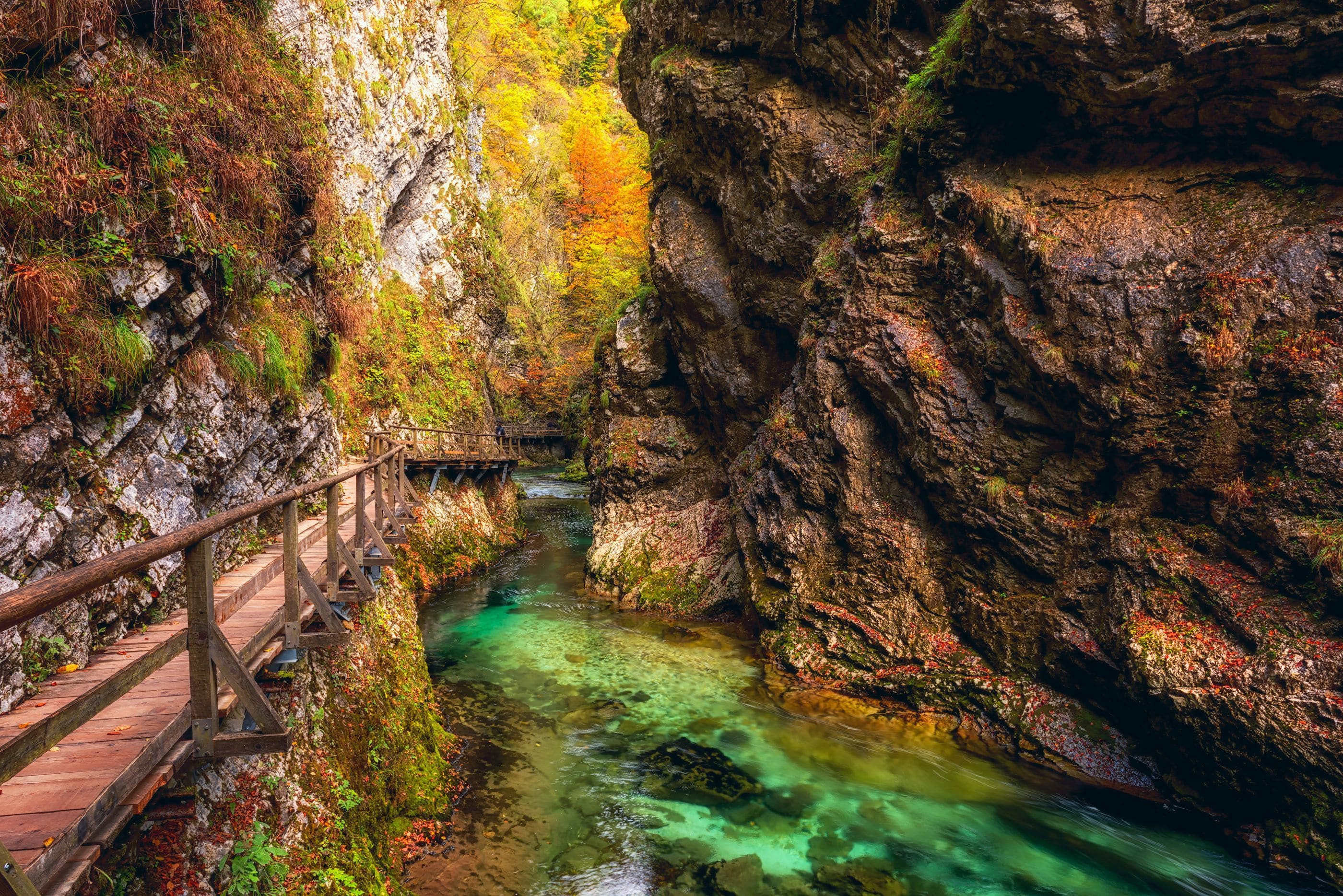
Vintgar Gorge
 Highlight of Excursion to Lake Bled
Highlight of Excursion to Lake BledFollow along the cliffsides deep into this incredibly scenic gorge.
Another outstanding sight near Lake Bled is Vintgar Gorge, an impressively deep one mile (1.6km) ravine about 2.5 miles (4km) north of town. It was not officially discovered until 1891, but now it's easily accessible via a continuous chain of wooden gantries and bridges, suspended from the precipitous rock face, and running the entire length of the gorge. There are a number of ways to get there, including on foot, by bike, train (take one from Jezero Bled station one stop to Podhom and follow the signs to the gorge), bus (they run frequently during the summer months from Bled bus station), or taxi. Also, ask for a map from the information center so you don't get lost. You should take into consideration, however, that the gorge is rather wet and a little bit slippery, and bottlenecks form on the narrow gantries during the height of the tourist season as people stop to take photos.

The Village of Radovljica and its Beekeeping Museum
 Highlight of Excursion to Lake Bled
Highlight of Excursion to Lake BledIf you like honey, chocolate, and gingerbread, make time for the small but exquisitely preserved medieval town of Radovljica, just 4 miles (6km) south-east of Bled.
Built on an outcrop above the River Sava and the beautiful Sava Valley, everything of interest in the town is centered around the wonderfully quiet Linhartov trg (Linhart Square), which is framed by Gothic and Renaissance buildings. The highlight is Thurn Mansion, clearly recognizable by its thickly stuccoed facade and vast spread of coats of arms. Inside, a magnificent double stairway leads up to the truly splendid Beekeeping Museum. Don't be fooled into thinking that it must invariably be a dull topic, as beekeeping is one of Slovenia's oldest and most celebrated traditions. After going over the history of beekeeping and examples of pioneering apiculture the undoubted high point of the museum is its collection of over 200 beehive panels - wooden end panels painted with religious, satirical or humorous motifs and scenes. Otherwise check out the Parish Church of St Peter just to the east of the museum, and the best-preserved houses on the square: no.3 Vidic House and no.22, the muralled Šiveč House. Radovljica also has a long chocolate and gingerbread-making tradition, so don't miss the live gingerbread workshop and museum at no.2 Pension Lectar.
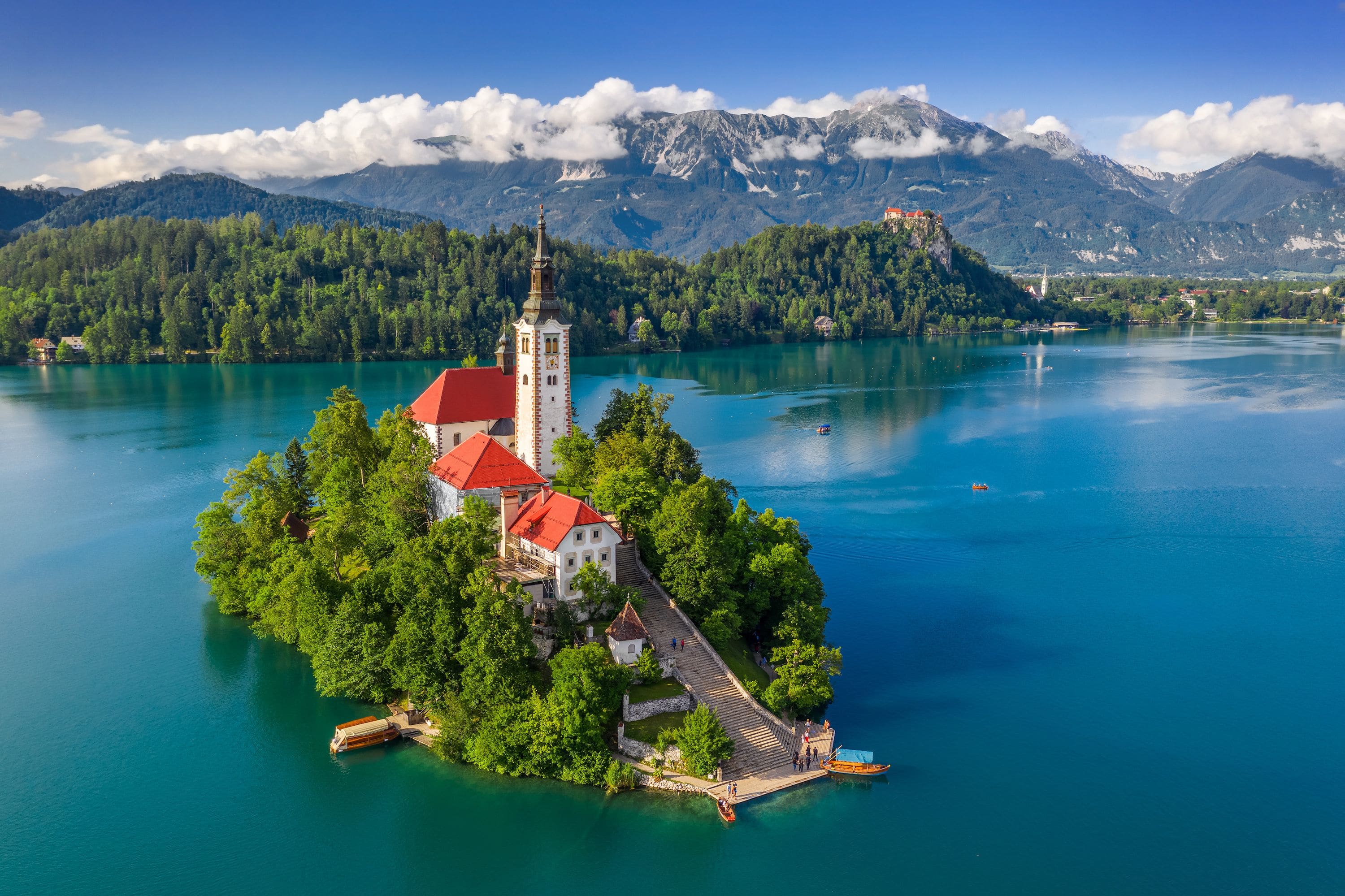
Bled Island
 Highlight of Excursion to Lake Bled
Highlight of Excursion to Lake BledRow (or be rowed) to this beautiful island in the center of Lake Bled.
The most recognizable symbol of Bled Island is the Church of the Assumption, although there are a handful of other buildings on the islet. The church dates from 1689 and its most outstanding features are the well-preserved frescoes. A wishing bell, which keeps many visitors amused, was installed in 1534, though a larger bell hangs in the enormous free-standing belfry. Weddings are held regularly in the church and traditionally it is considered good luck for a groom to carry his bride up the 99 stone steps on the day of their wedding before ringing the bell and making a wish inside the church. Numerous pletna boats take passengers to the island. A pletna looks sort of like a Venetian gondola, but wider. You'll pay about 15 EUR for a return journey, which includes 25min there, 40min on the island itself, and another 25min back, i.e. an hour-and-a-half altogether. The pletna oarsmen will be happy to answer your questions as you make your way across the lake. Only locals are permitted to operate a pletna. The tradition has been passed from generation to generation for the past few centuries. The pletna operate all year round depending on the weather. If you want to expend your own energy to get across the lake, then there a number of places around the lakeshore where you can rent a rowboat and get to the island under your own steam. There's also a motorized ferry that runs regularly from the main tourist information office for around 12 EUR.
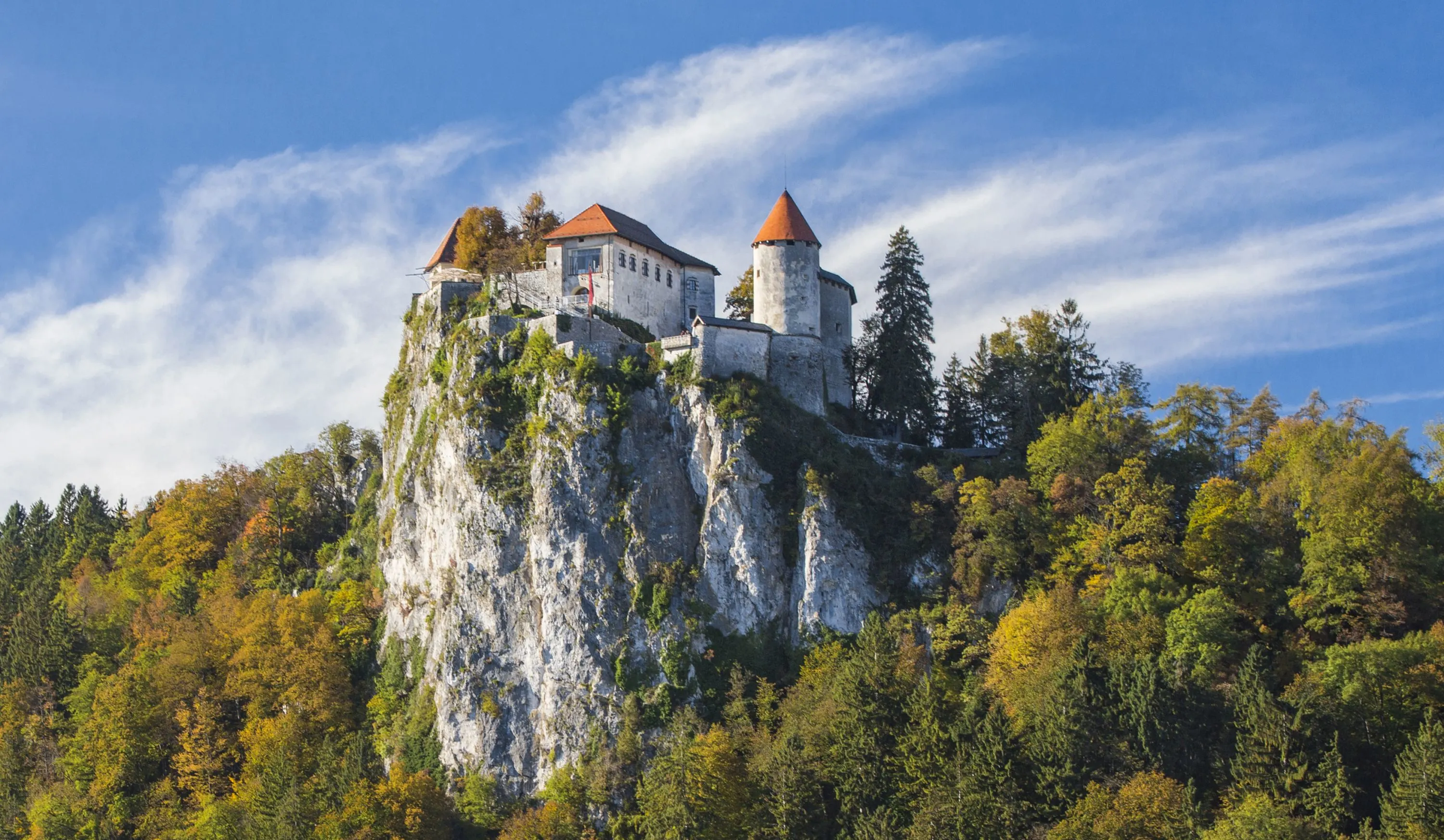
Bled Castle
 Highlight of Excursion to Lake Bled
Highlight of Excursion to Lake BledStare down at the lake from this dramatic castle precariously perched on a cliff.
Perched up high on a precipitous craggy bluff near the town center is Bled Castle, enclosed by a Romanesque wall and studded with stout parapets, towers and ramparts, just as any medieval castle should be. Originally constructed in the 11th century, the castle's present appearance dates from the 17th century, and is characterized by a lower and upper courtyard. Probably its best feature is the beautiful chapel. There are outstanding views from the castle terrace of the lake and island below, while the castle restaurant has a reputation as one of the best in Lake Bled. Close by at the start of one of the tracks leading up to the castle you'll also find the photogenic Parish Church of St Martin.

Vintgar Gorge
 Highlight of Excursion to Lake Bled
Highlight of Excursion to Lake BledFollow along the cliffsides deep into this incredibly scenic gorge.
Another outstanding sight near Lake Bled is Vintgar Gorge, an impressively deep one mile (1.6km) ravine about 2.5 miles (4km) north of town. It was not officially discovered until 1891, but now it's easily accessible via a continuous chain of wooden gantries and bridges, suspended from the precipitous rock face, and running the entire length of the gorge. There are a number of ways to get there, including on foot, by bike, train (take one from Jezero Bled station one stop to Podhom and follow the signs to the gorge), bus (they run frequently during the summer months from Bled bus station), or taxi. Also, ask for a map from the information center so you don't get lost. You should take into consideration, however, that the gorge is rather wet and a little bit slippery, and bottlenecks form on the narrow gantries during the height of the tourist season as people stop to take photos.

The Village of Radovljica and its Beekeeping Museum
 Highlight of Excursion to Lake Bled
Highlight of Excursion to Lake BledIf you like honey, chocolate, and gingerbread, make time for the small but exquisitely preserved medieval town of Radovljica, just 4 miles (6km) south-east of Bled.
Built on an outcrop above the River Sava and the beautiful Sava Valley, everything of interest in the town is centered around the wonderfully quiet Linhartov trg (Linhart Square), which is framed by Gothic and Renaissance buildings. The highlight is Thurn Mansion, clearly recognizable by its thickly stuccoed facade and vast spread of coats of arms. Inside, a magnificent double stairway leads up to the truly splendid Beekeeping Museum. Don't be fooled into thinking that it must invariably be a dull topic, as beekeeping is one of Slovenia's oldest and most celebrated traditions. After going over the history of beekeeping and examples of pioneering apiculture the undoubted high point of the museum is its collection of over 200 beehive panels - wooden end panels painted with religious, satirical or humorous motifs and scenes. Otherwise check out the Parish Church of St Peter just to the east of the museum, and the best-preserved houses on the square: no.3 Vidic House and no.22, the muralled Šiveč House. Radovljica also has a long chocolate and gingerbread-making tradition, so don't miss the live gingerbread workshop and museum at no.2 Pension Lectar.

Bled Island
 Highlight of Excursion to Lake Bled
Highlight of Excursion to Lake BledRow (or be rowed) to this beautiful island in the center of Lake Bled.
The most recognizable symbol of Bled Island is the Church of the Assumption, although there are a handful of other buildings on the islet. The church dates from 1689 and its most outstanding features are the well-preserved frescoes. A wishing bell, which keeps many visitors amused, was installed in 1534, though a larger bell hangs in the enormous free-standing belfry. Weddings are held regularly in the church and traditionally it is considered good luck for a groom to carry his bride up the 99 stone steps on the day of their wedding before ringing the bell and making a wish inside the church. Numerous pletna boats take passengers to the island. A pletna looks sort of like a Venetian gondola, but wider. You'll pay about 15 EUR for a return journey, which includes 25min there, 40min on the island itself, and another 25min back, i.e. an hour-and-a-half altogether. The pletna oarsmen will be happy to answer your questions as you make your way across the lake. Only locals are permitted to operate a pletna. The tradition has been passed from generation to generation for the past few centuries. The pletna operate all year round depending on the weather. If you want to expend your own energy to get across the lake, then there a number of places around the lakeshore where you can rent a rowboat and get to the island under your own steam. There's also a motorized ferry that runs regularly from the main tourist information office for around 12 EUR.

Bled Castle
 Highlight of Excursion to Lake Bled
Highlight of Excursion to Lake BledStare down at the lake from this dramatic castle precariously perched on a cliff.
Perched up high on a precipitous craggy bluff near the town center is Bled Castle, enclosed by a Romanesque wall and studded with stout parapets, towers and ramparts, just as any medieval castle should be. Originally constructed in the 11th century, the castle's present appearance dates from the 17th century, and is characterized by a lower and upper courtyard. Probably its best feature is the beautiful chapel. There are outstanding views from the castle terrace of the lake and island below, while the castle restaurant has a reputation as one of the best in Lake Bled. Close by at the start of one of the tracks leading up to the castle you'll also find the photogenic Parish Church of St Martin.
prev
next


Day 10
Depart Ljubljana
View More
Day 10
Depart Ljubljana

To Be Determined
Transfer to Ljubljana Airport by Taxi
Ljubljana has one main airport, Ljubljana Airport, also known as Ljubljana Jože Pučnik Airport, where almost all visitors depart. You can also arrange a private transfer for added convenience. If you are picked up about two hours and forty-five minutes before your departure time, you should arrive at the airport with about two hours to spare, depending on traffic. The cost should be about 35 EUR. It is a very small airport so you should have little trouble finding your way upon arrival at the airport.

Day 10
Depart Ljubljana
View More


What's Included In Your Trip

Pre-Paid Tours and Activities:
- Guided Walking Tour of Dubrovnik's Old Town
- Walking Tour of Split Old Town & Diocletian's Palace
- Guided Tour of Plitvice Lakes
- Guided Walking Tour of Ljubljana

Pre-Paid Transportation:
- Catamaran ferry from Dubrovnik-Split
- Shuttle Service from Split to Plitvice Lakes
- Shuttle Service from Plitvice Lakes to Ljubljana

Accommodation:
- 3 nights at a hotel of your choice in Dubrovnik
- 3 nights at a hotel of your choice in Split
- 3 nights at a hotel of your choice in Plitvice Lakes
- 4 nights at a hotel of your choice in Ljubljana

Go Real Travel Mobile App:
- Itinerary Plan & Reservations Info
- Points of Interest
- Detailed Travel Information
- Maps & Directions
Other Trips You May Like

7 Days
From$699USD

10 Days
From$1940USD

10 Days
From$1749USD
From the Adriatic to Europe's Heart: Exploring Croatia, Budapest, and Prague

Croatia, Hungary, Czech Republic
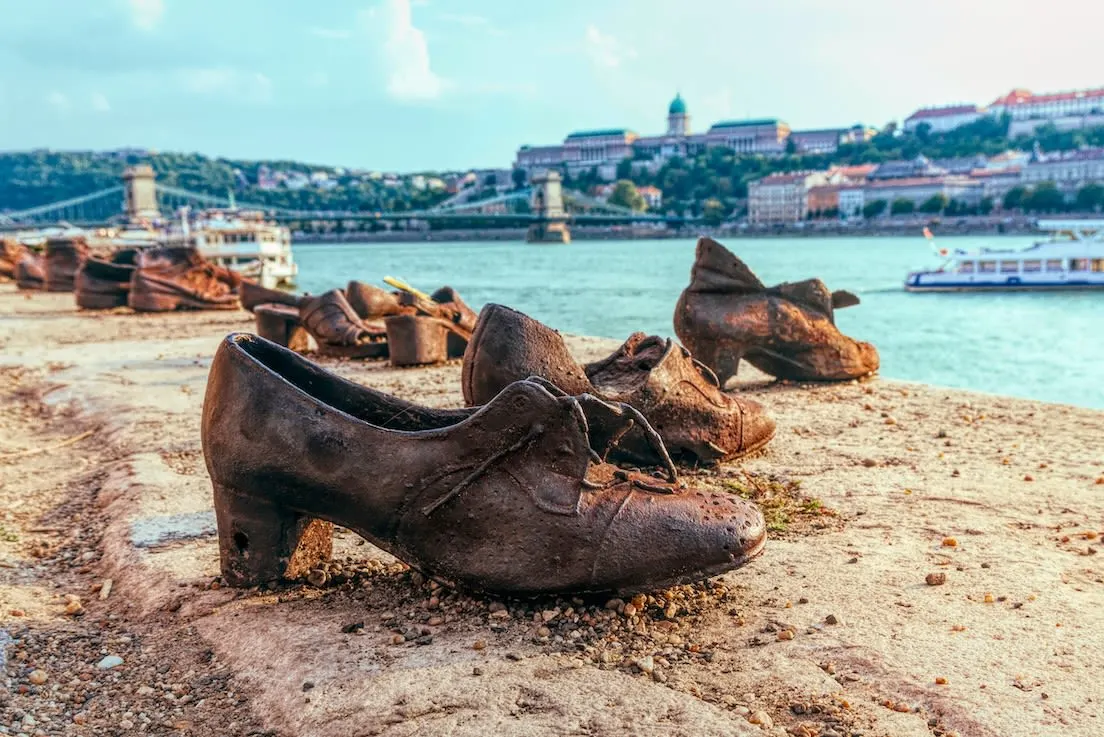
4 Days
From$897USD
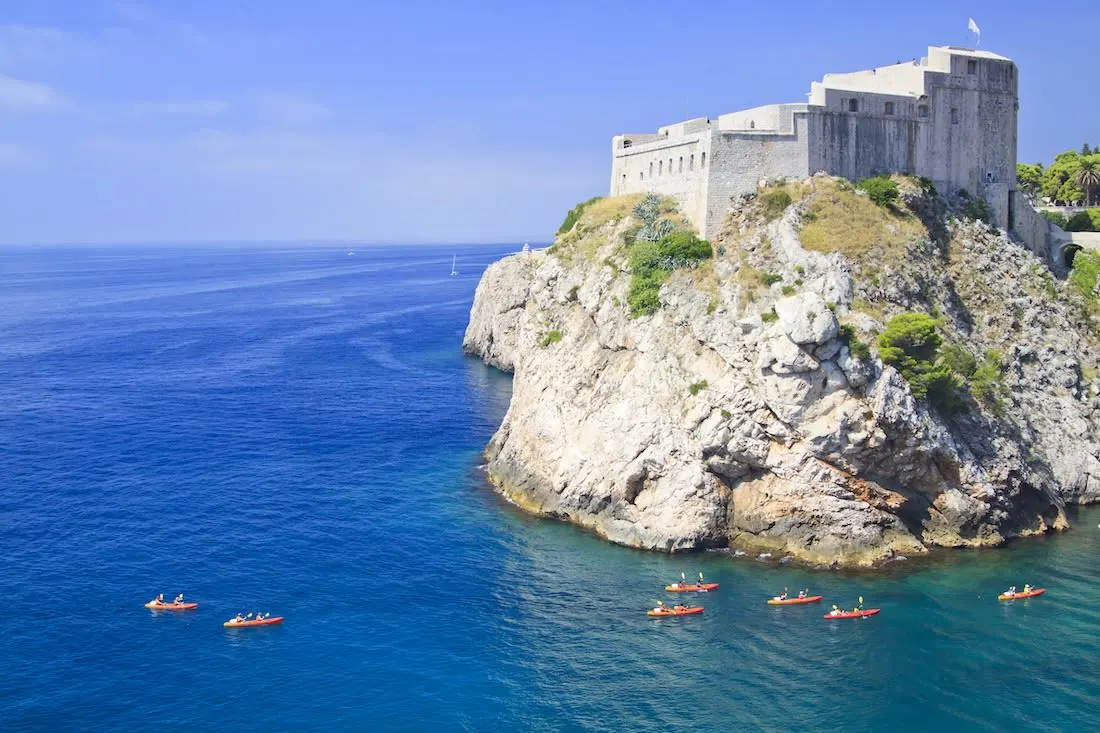
14 Days
From$3495USD

7 Days
From$1525USD
Captivating Croatia & Slovenia: A Week of Coastal Charms and Alpine Wonders

Croatia, Slovenia

7 Days
From$1390USD

10 Days
From$2750USD

8 Days
From$1585USD

7 Days
From$699USD

10 Days
From$1940USD

10 Days
From$1749USD
From the Adriatic to Europe's Heart: Exploring Croatia, Budapest, and Prague

Croatia, Hungary, Czech Republic

4 Days
From$897USD

14 Days
From$3495USD

7 Days
From$1525USD
Captivating Croatia & Slovenia: A Week of Coastal Charms and Alpine Wonders

Croatia, Slovenia

7 Days
From$1390USD

10 Days
From$2750USD

8 Days
From$1585USD
prev
next
Featured Blogs
prev
next
Our Customers Say It Best
Otto Chuy, Los Angeles, California
I am still surprised how everything worked as planned, without a hitch. All instructions in your itinerary were precise and correct. Your suggestions and comments in each of the locations we went to were very helpful. All your guides, without exception, were wonderful and exactly on time. 

Kathy Mongeau, Ottawa, Ontario
My sister, Ann Ibberson, and I have been back home for a few weeks now and still go on and on about our fabulous trip. We were just blown away in every respect. Given the fact that we only had 1 ½ weeks, you had everything arranged for us so efficiently and your contacts who we dealt with for transfers, tours, hotels were extremely professional and personable. Things could not have gone better. 

Clive Andrew, Brisbane, Queensland
Just a quick note to let you know that I am back home now after probably the best overseas holiday that I have ever had, in no small part due to your very capable organization booking of hotels, tours, & trains. There was just nothing that went wrong with the timings etc. 

Malini Dutta, Boston, Massachusetts
We can't thank you enough for the detailed plans, maps, and suggestions. It really felt that someone was holding our hands and showing us around. We had all the excitement of discovering foreign lands, with none of the problems that can happen while negotiating unfamiliar places. In fact, all the cities felt like home within a few hours of arriving and exploring. 

Bev and Mark Frankel, Williamsburg, Virginia
We could not be more pleased with Go Real Travel! You took the guess work out of things like public transport but still managed to allow us the freedom to tour as we wanted. Our guides were exceptional and every time I saw a Viking Cruise tour of 25 people, I realized the quality experience we were getting with Go Real. 

Marianne Strydom, Paarl, South Africa
I just wanted to thank you for organizing an amazing trip for me – I packed in so much in such a short period of time and everything was just perfect. The way you do things makes it possible to really get to know the destination, which for me as a travel agent could not have been better. 

Otto Chuy, Los Angeles, California
I am still surprised how everything worked as planned, without a hitch. All instructions in your itinerary were precise and correct. Your suggestions and comments in each of the locations we went to were very helpful. All your guides, without exception, were wonderful and exactly on time. 

Kathy Mongeau, Ottawa, Ontario
My sister, Ann Ibberson, and I have been back home for a few weeks now and still go on and on about our fabulous trip. We were just blown away in every respect. Given the fact that we only had 1 ½ weeks, you had everything arranged for us so efficiently and your contacts who we dealt with for transfers, tours, hotels were extremely professional and personable. Things could not have gone better. 

Clive Andrew, Brisbane, Queensland
Just a quick note to let you know that I am back home now after probably the best overseas holiday that I have ever had, in no small part due to your very capable organization booking of hotels, tours, & trains. There was just nothing that went wrong with the timings etc. 

Malini Dutta, Boston, Massachusetts
We can't thank you enough for the detailed plans, maps, and suggestions. It really felt that someone was holding our hands and showing us around. We had all the excitement of discovering foreign lands, with none of the problems that can happen while negotiating unfamiliar places. In fact, all the cities felt like home within a few hours of arriving and exploring. 

Bev and Mark Frankel, Williamsburg, Virginia
We could not be more pleased with Go Real Travel! You took the guess work out of things like public transport but still managed to allow us the freedom to tour as we wanted. Our guides were exceptional and every time I saw a Viking Cruise tour of 25 people, I realized the quality experience we were getting with Go Real. 

Marianne Strydom, Paarl, South Africa
I just wanted to thank you for organizing an amazing trip for me – I packed in so much in such a short period of time and everything was just perfect. The way you do things makes it possible to really get to know the destination, which for me as a travel agent could not have been better. 



Explore cities in more detail
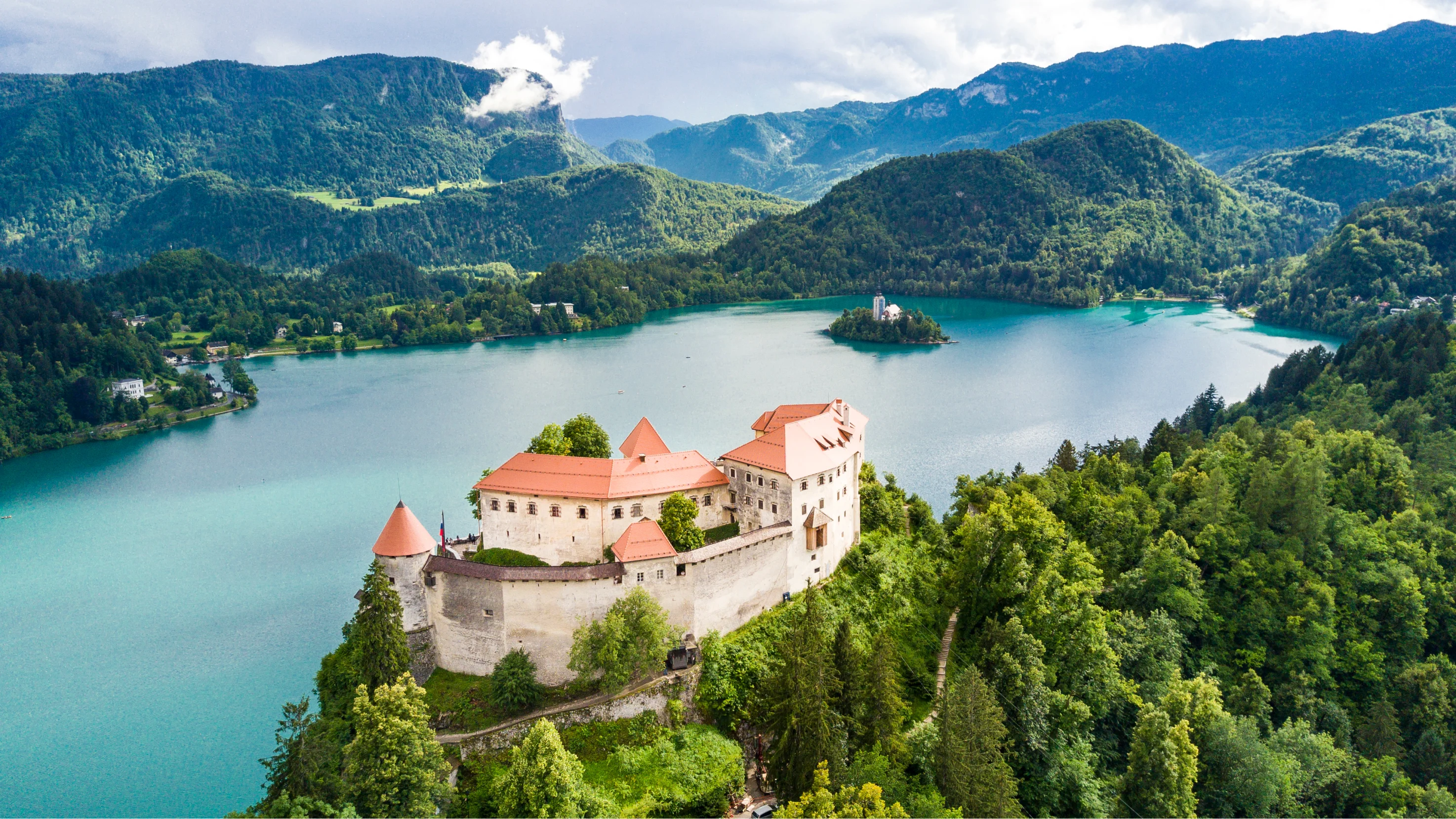
Ljubljana
One of Europe's smallest capitals, Ljubljana is still Slovenia's biggest city. What it lacks in size, though, it more than makes up for in charm, beauty, and personality. It's also one of Europe's greenest cities and is perfect for a bike ride or a leisurely walk. With plenty of open spaces, gorgeous architecture, and cultural treats, it's easy to fill the time here. The Tromostovje, or Triple Bridge, is one of Ljubljana's main attractions, connecting the Old Town with the new. Excellent pizza can be found here, and a series of bars and cafes are dotted throughout the town and along the banks of the river. The anarchic Metelkova City reveals Ljubljana's grittier side, with art exhibitions and performances housed in a disused military barracks. Ljubljana is charm and beauty compressed neatly into a small and pretty space.
Read More
Learn About Ljubljana
Build Ljubljana Trip
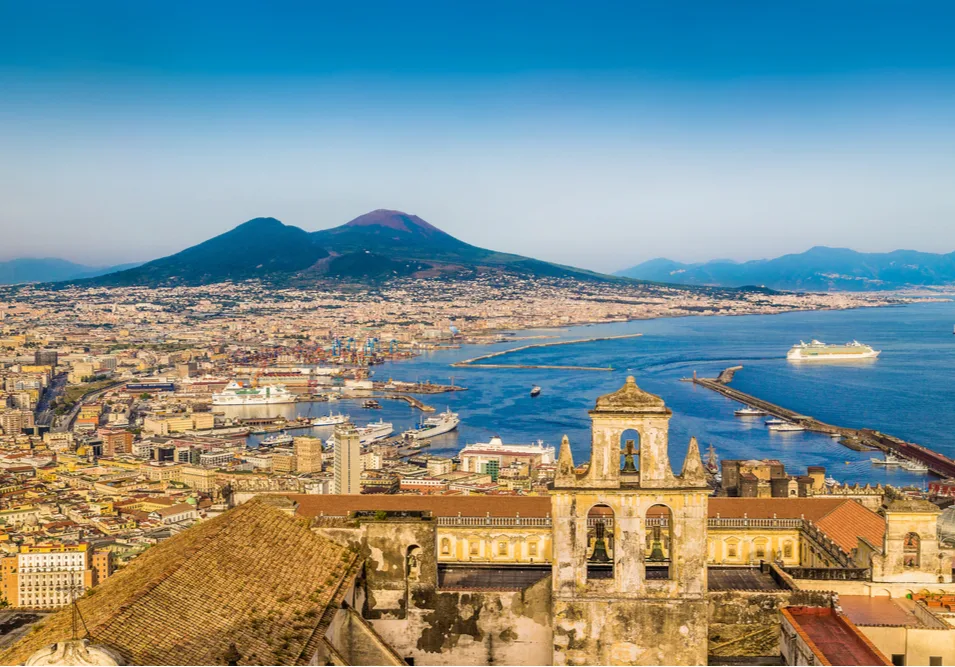
Naples
Gritty and chaotic Naples calls to travelers who want to experience the real Italy. Pressed along the coast of Campania, hilly Naples is jammed with maze-like streets, strung with outdoor clotheslines, descending toward the sea below. A much deserved UNESCO World Heritage site, Naples is famous for its churches, museums, castles, and catacombs. As you navigate the city, you’ll find yourself immersed by its culture and history. You can easily occupy a full day gazing at churches like the Naples Cathedral, San Francesco di Paola, and Cappella Sansevero. If you cast your eyes toward the Gulf of Naples, you’ll see Mount Vesuvius looming over the harbor. This foreboding volcano erupted in AD 79. Not far from the inner city — less than an hour by train — you’ll find the ancient town of Pompeii, its dramatic ruins still preserved in ash from the eruption. One of the best things you can do in Naples is to eat. This is the city where pizza was born. Propped up by its ripe tomatoes, local cheeses, and fresh fish, food from Naples has come to define what many see as the height of Italian cuisine. Everything you taste in Naples seems like a delicacy. Authentic and vivid, Naples is a true Italian city where the ancient world meets the modern-day with a bang.
Read More
Learn About Naples
Build Naples Trip
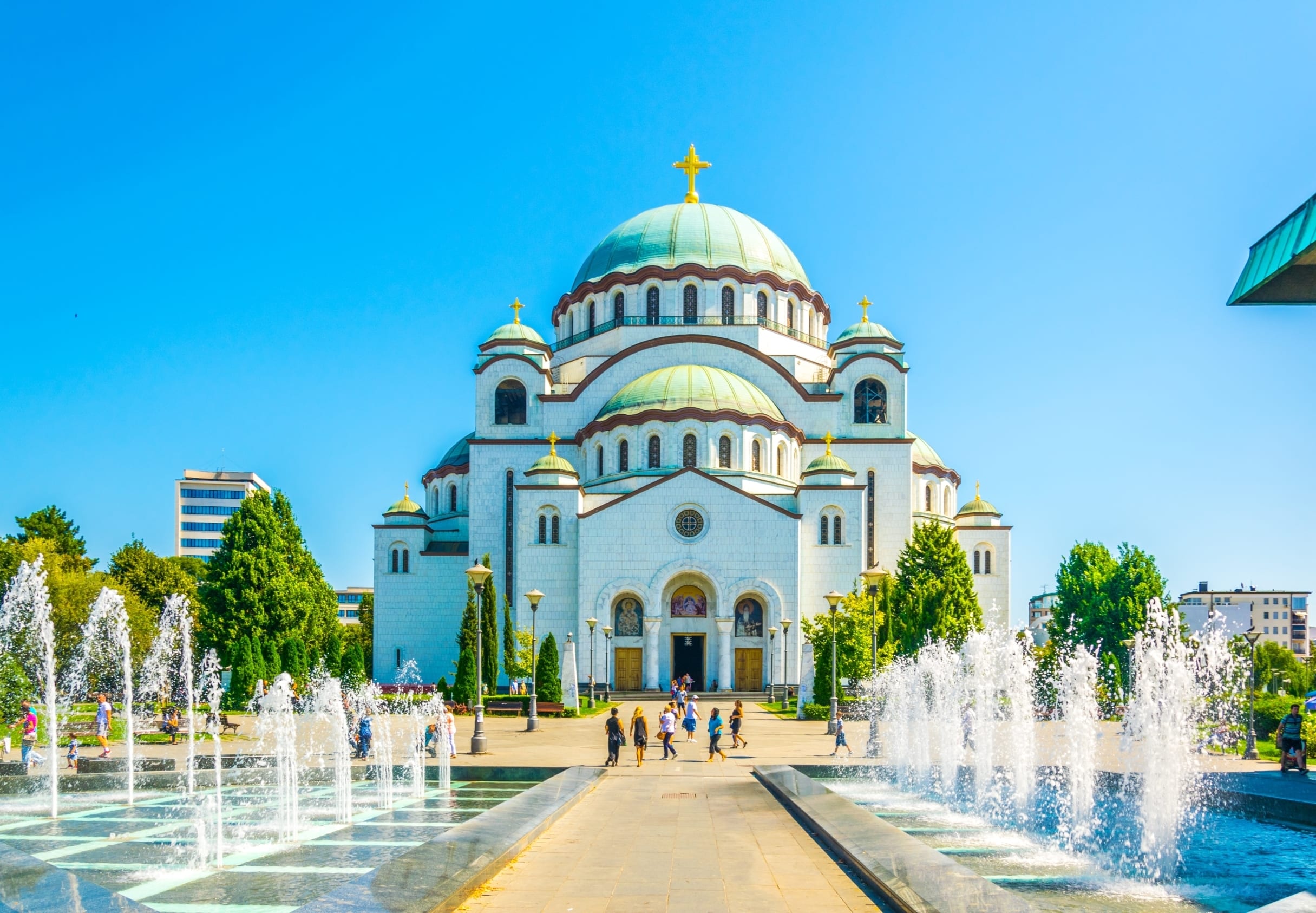
Belgrade
Belgrade is one of Europe’s oldest cities and with age comes experience. Remnants of the city’s turbulent past can be seen easily during a stroll through the streets: socialist blocks sit beside art nouveau buildings, while fragments of the Habsburg monarchy contrast with Ottoman Turk relics. If you’re looking to take in a little history, you’ll have a lot to choose from between the city’s many museums, monuments, and of course, the fortress. What Belgrade lacks in traditional beauty it makes up for in personality. Belgrade is first and foremost known for its unrivaled nightlife scene. Appropriately named the city that never sleeps, after the sun goes down you can explore floating clubs on the river, hip bars around the center, and great parties everywhere you look. During the daylight hours, you’ll find busy locals bustling around the business centers, relaxing in elegant coffee houses, or wandering through the city’s many beautiful parks.
Read More
Learn About Belgrade
Build Belgrade Trip
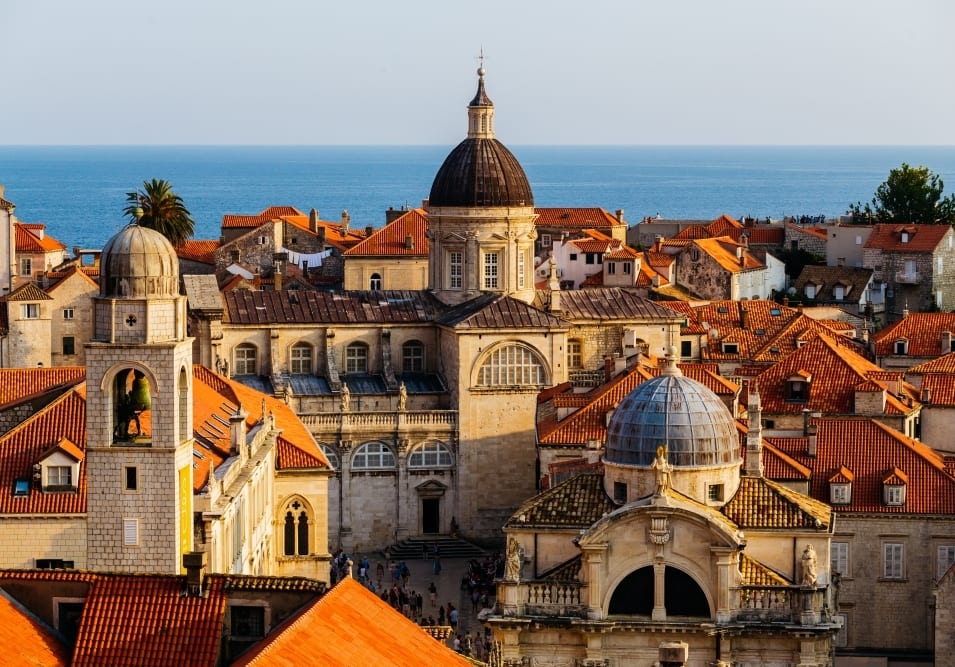
Dubrovnik
Situated in southern Croatia on the Adriatic Sea, Dubrovnik is famous for many different reasons. Everywhere you look in Dubrovnik is a stunning view. Known for its beautiful Old Town and ancient walls, Dubrovnik is a resilient city that deserves its nickname as the pearl of the Adriatic. Strolling through the limestone streets lined with baroque buildings, alongside the animated locals, will inspire you to keep exploring. The city walls offer spectacular views of the red rooftops in Old Town and the shimmering blues of the Adriatic Sea. After a tiring trek in the hot Croatian sun, cool off at one of Dubrovnik’s divine pebbly beaches and go swimming in the sea. The best way to end the day is a visit to Stradun, the main street, to pop into one of the cafes or restaurants, and relax during a delicious meal of Croatian specialties and wine.
Read More
Learn About Dubrovnik
Build Dubrovnik Trip
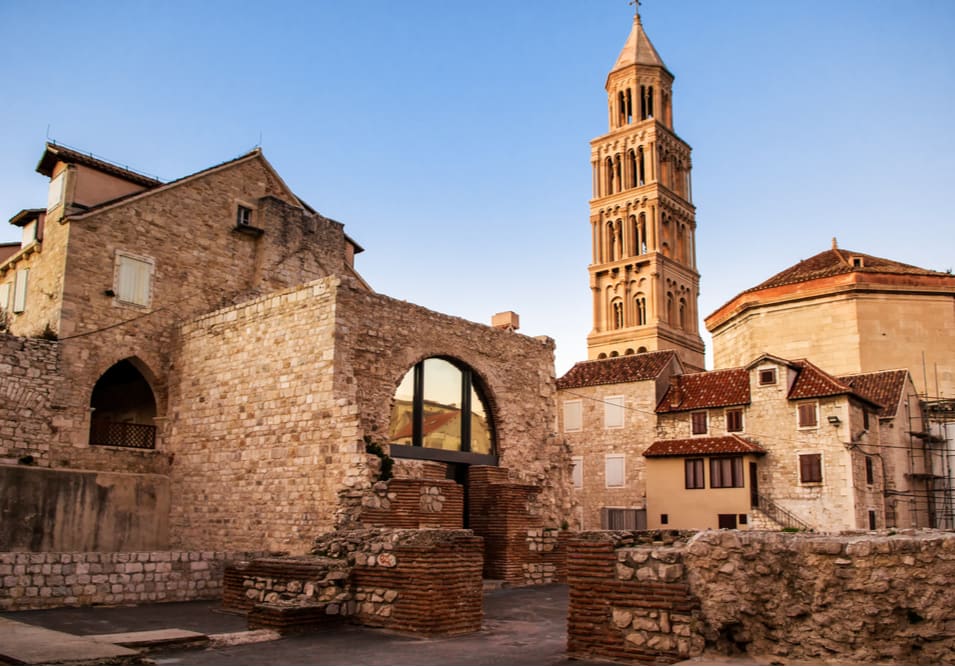
Split
A lively port city situated between mountains and sea, Split is one of Croatia's most visited—and most beautiful— cities. With historical monuments sprinkled across the Dalmatian coastline and trendy cafes and shops popping up within the ancient walls of the city center, it's easy to see why this extraordinary city is such a popular travel destination. Split is always abuzz with visitors and locals alike enjoying a seafood meal outside, relaxing on the beach, or boating on the Adriatic. The weather is almost always beautiful, so the streets tend to be crowded with people looking to take advantage of the sunshine. A walk through Split feels like a journey through past centuries. The coastal town showcases modern architecture next to structures like Diocletian's Palace, which date back to the times of the Roman Empire. In fact, Split's Old Town resides within the walls of Diocletian's Palace. As you stroll through the narrow marble streets, you'll be amazed by the number of modern restaurants and bars populating this ancient area. It's easy to pack plenty of culture, history, activity, and leisure all into one amazing trip.
Read More
Learn About Split
Build Split Trip
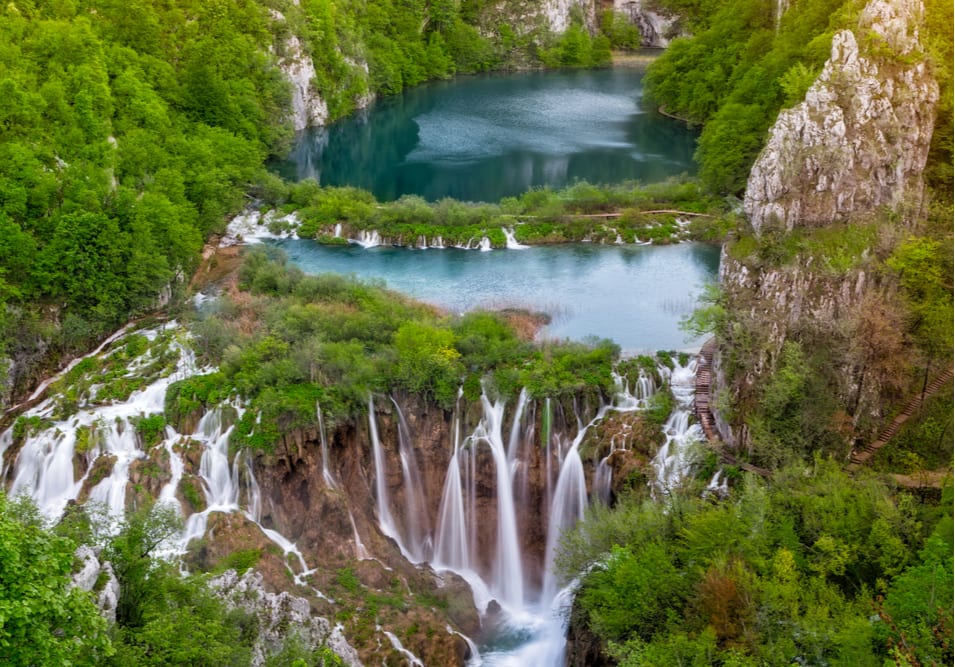
Plitvice Lakes
Plitvice Lakes in Croatia is a national park featuring 16 interconnected lakes. It was once one of Yugoslavia’s most popular tourist hotspots, and today this UNESCO World Heritage Site attracts visitors from all over the world. The lakes’ main draw is their sublime natural beauty. Turquoise pools, joined by a series of waterfalls and cascades, are set like jewels within the park’s lush green hillsides. Wooden hiking paths snake between the lakes and along the shores. Plitvice hosts an impressive variety of wildlife, from wild boars and dormice to hundreds of butterfly species, and countless types of birds. The park’s most famous resident is the elusive brown bear. Occupied by hostile forces during the Croatian War of Independence, this park’s history isn’t all paradisical. However, it’s easy to forget that troubled past when spending time by the lakes today. Today, Plitvice’s mood is all about peace, relaxation, and appreciation of stunning natural beauty.
Read More
Learn About Plitvice Lakes
Build Plitvice Lakes Trip

Ljubljana
One of Europe's smallest capitals, Ljubljana is still Slovenia's biggest city. What it lacks in size, though, it more than makes up for in charm, beauty, and personality. It's also one of Europe's greenest cities and is perfect for a bike ride or a leisurely walk. With plenty of open spaces, gorgeous architecture, and cultural treats, it's easy to fill the time here. The Tromostovje, or Triple Bridge, is one of Ljubljana's main attractions, connecting the Old Town with the new. Excellent pizza can be found here, and a series of bars and cafes are dotted throughout the town and along the banks of the river. The anarchic Metelkova City reveals Ljubljana's grittier side, with art exhibitions and performances housed in a disused military barracks. Ljubljana is charm and beauty compressed neatly into a small and pretty space.
Read More
Learn About Ljubljana
Build Ljubljana Trip

Naples
Gritty and chaotic Naples calls to travelers who want to experience the real Italy. Pressed along the coast of Campania, hilly Naples is jammed with maze-like streets, strung with outdoor clotheslines, descending toward the sea below. A much deserved UNESCO World Heritage site, Naples is famous for its churches, museums, castles, and catacombs. As you navigate the city, you’ll find yourself immersed by its culture and history. You can easily occupy a full day gazing at churches like the Naples Cathedral, San Francesco di Paola, and Cappella Sansevero. If you cast your eyes toward the Gulf of Naples, you’ll see Mount Vesuvius looming over the harbor. This foreboding volcano erupted in AD 79. Not far from the inner city — less than an hour by train — you’ll find the ancient town of Pompeii, its dramatic ruins still preserved in ash from the eruption. One of the best things you can do in Naples is to eat. This is the city where pizza was born. Propped up by its ripe tomatoes, local cheeses, and fresh fish, food from Naples has come to define what many see as the height of Italian cuisine. Everything you taste in Naples seems like a delicacy. Authentic and vivid, Naples is a true Italian city where the ancient world meets the modern-day with a bang.
Read More
Learn About Naples
Build Naples Trip

Belgrade
Belgrade is one of Europe’s oldest cities and with age comes experience. Remnants of the city’s turbulent past can be seen easily during a stroll through the streets: socialist blocks sit beside art nouveau buildings, while fragments of the Habsburg monarchy contrast with Ottoman Turk relics. If you’re looking to take in a little history, you’ll have a lot to choose from between the city’s many museums, monuments, and of course, the fortress. What Belgrade lacks in traditional beauty it makes up for in personality. Belgrade is first and foremost known for its unrivaled nightlife scene. Appropriately named the city that never sleeps, after the sun goes down you can explore floating clubs on the river, hip bars around the center, and great parties everywhere you look. During the daylight hours, you’ll find busy locals bustling around the business centers, relaxing in elegant coffee houses, or wandering through the city’s many beautiful parks.
Read More
Learn About Belgrade
Build Belgrade Trip

Dubrovnik
Situated in southern Croatia on the Adriatic Sea, Dubrovnik is famous for many different reasons. Everywhere you look in Dubrovnik is a stunning view. Known for its beautiful Old Town and ancient walls, Dubrovnik is a resilient city that deserves its nickname as the pearl of the Adriatic. Strolling through the limestone streets lined with baroque buildings, alongside the animated locals, will inspire you to keep exploring. The city walls offer spectacular views of the red rooftops in Old Town and the shimmering blues of the Adriatic Sea. After a tiring trek in the hot Croatian sun, cool off at one of Dubrovnik’s divine pebbly beaches and go swimming in the sea. The best way to end the day is a visit to Stradun, the main street, to pop into one of the cafes or restaurants, and relax during a delicious meal of Croatian specialties and wine.
Read More
Learn About Dubrovnik
Build Dubrovnik Trip

Split
A lively port city situated between mountains and sea, Split is one of Croatia's most visited—and most beautiful— cities. With historical monuments sprinkled across the Dalmatian coastline and trendy cafes and shops popping up within the ancient walls of the city center, it's easy to see why this extraordinary city is such a popular travel destination. Split is always abuzz with visitors and locals alike enjoying a seafood meal outside, relaxing on the beach, or boating on the Adriatic. The weather is almost always beautiful, so the streets tend to be crowded with people looking to take advantage of the sunshine. A walk through Split feels like a journey through past centuries. The coastal town showcases modern architecture next to structures like Diocletian's Palace, which date back to the times of the Roman Empire. In fact, Split's Old Town resides within the walls of Diocletian's Palace. As you stroll through the narrow marble streets, you'll be amazed by the number of modern restaurants and bars populating this ancient area. It's easy to pack plenty of culture, history, activity, and leisure all into one amazing trip.
Read More
Learn About Split
Build Split Trip

Plitvice Lakes
Plitvice Lakes in Croatia is a national park featuring 16 interconnected lakes. It was once one of Yugoslavia’s most popular tourist hotspots, and today this UNESCO World Heritage Site attracts visitors from all over the world. The lakes’ main draw is their sublime natural beauty. Turquoise pools, joined by a series of waterfalls and cascades, are set like jewels within the park’s lush green hillsides. Wooden hiking paths snake between the lakes and along the shores. Plitvice hosts an impressive variety of wildlife, from wild boars and dormice to hundreds of butterfly species, and countless types of birds. The park’s most famous resident is the elusive brown bear. Occupied by hostile forces during the Croatian War of Independence, this park’s history isn’t all paradisical. However, it’s easy to forget that troubled past when spending time by the lakes today. Today, Plitvice’s mood is all about peace, relaxation, and appreciation of stunning natural beauty.
Read More
Learn About Plitvice Lakes
Build Plitvice Lakes Trip
prev
next


 Map of Your Itinerary Route
Map of Your Itinerary Route
Zoom In to the cities to see your itinerary in more detail


 4.8
4.8 
